So here it is: another holiday season! I hope you are feeling as festive as I am. Jingle! Jingle!! What are your holiday plans?
Christmas Eve is traditionally spent with the Troeschels, and this year, Tom’s brother and sister-in-law, Paul and Chris, will graciously host the family at their beautiful home bejeweled in the season’s splendor. Then on Christmas, my family is coming to our place. Because my sisters love cooking AND are so good at it, they have offered to bring all the food. Sweet, right? Oh, I might get a few “store bought” pies 😉
Now I want to share a preview of our newest shipment fresh from Scandinavia. It’s a classic full of favorites: sculptural clocks, fitted secretary desks, vitrine cabinets, pairs of chests, and other clean-line pieces. So when you are out shopping or running errands, please pop in.
Many Swedish painted secretaries have also arrived. This tall one, made in two parts, has a plethora of drawers. It would make a stunning statement piece in a foyer, living room or bedroom. With a silver tray on the desk and doors opened to showcase plates, it would be smashing and unexpected in the dining room.
Do you like the secretary accessorized with creamware or topiaries?
Let’s check out a few new “old” tables. ABOVE: A Rococo free-standing table with shaped apron on all sides. BELOW: A Gustavian small console having narrow depth.
I have a fondness for tea tables, game tables or consoles with candle slides. They take me back to a time illuminated by candlelight.
When it comes to cabinets, I like them tall; the taller the better! This Ca 1790s vitrine is the quintessential Swedish Gustavian case piece with its humble form and quiet elegance. Standing at 92″ high, it somehow seems to float on those little feet.
Flanking the vitrine is a near pair of Swedish blue painted chests in the Gustavian style.
Mixing Swedish with French. Both the Louis Philippe walnut armoire and landscape painting are French. The Baroque chair (Ca 1760s) and pair of bedside tables are Swedish.
Pale and definitely very Swedish in this corner. Another super tall vitrine with Gustavian armchairs and cabinet with trompe l’oeil laurel wreaths.
BELOW: An 18th century Baltic console with later painted surface. The white faience piece on top is a French brassero from the Directoire period (Ca 1790s). It once served as an elegant portable heater.
Stools and benches! Need some?
A charming small commode with an unusual arrangement of five graduated drawers. Here’s a mini Perrier for scale.
Shown here is one of a pair of Danish Empire style elmwood open armchairs with pronounced scrolls. The pair of narrow pedestal cabinets are Swedish. They would look smart flanking a doorway – perhaps with plants, urns or hurricanes on top?
And last is this Swedish linen press or cupboard painted in a rich shade of blue gray.

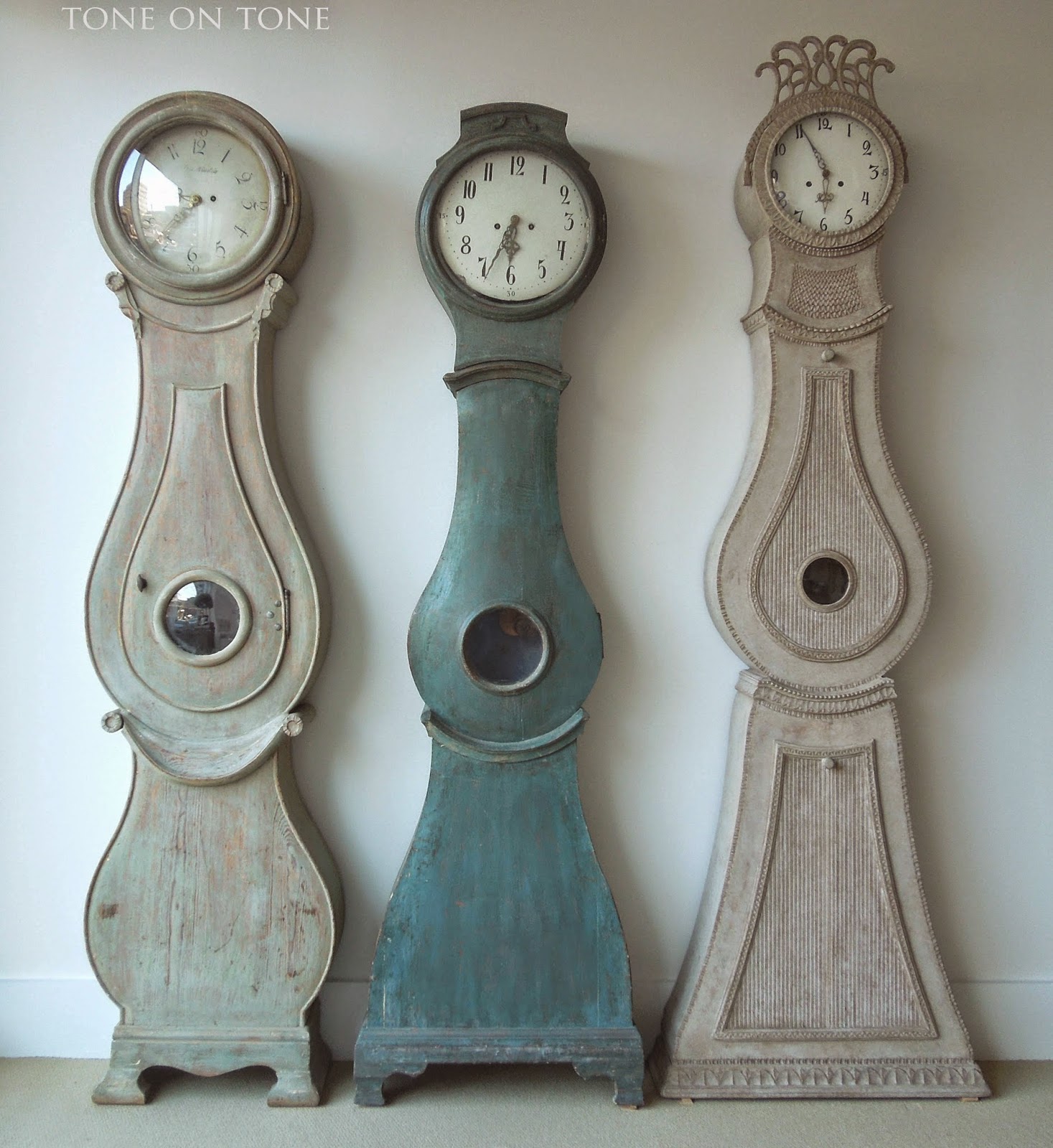
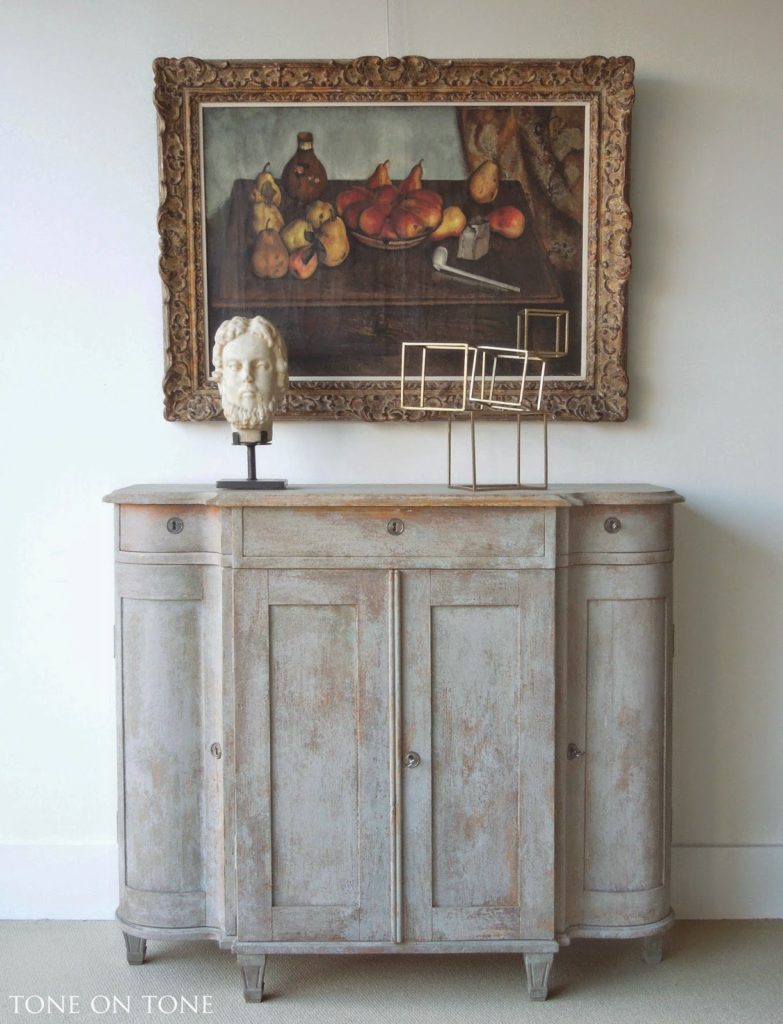
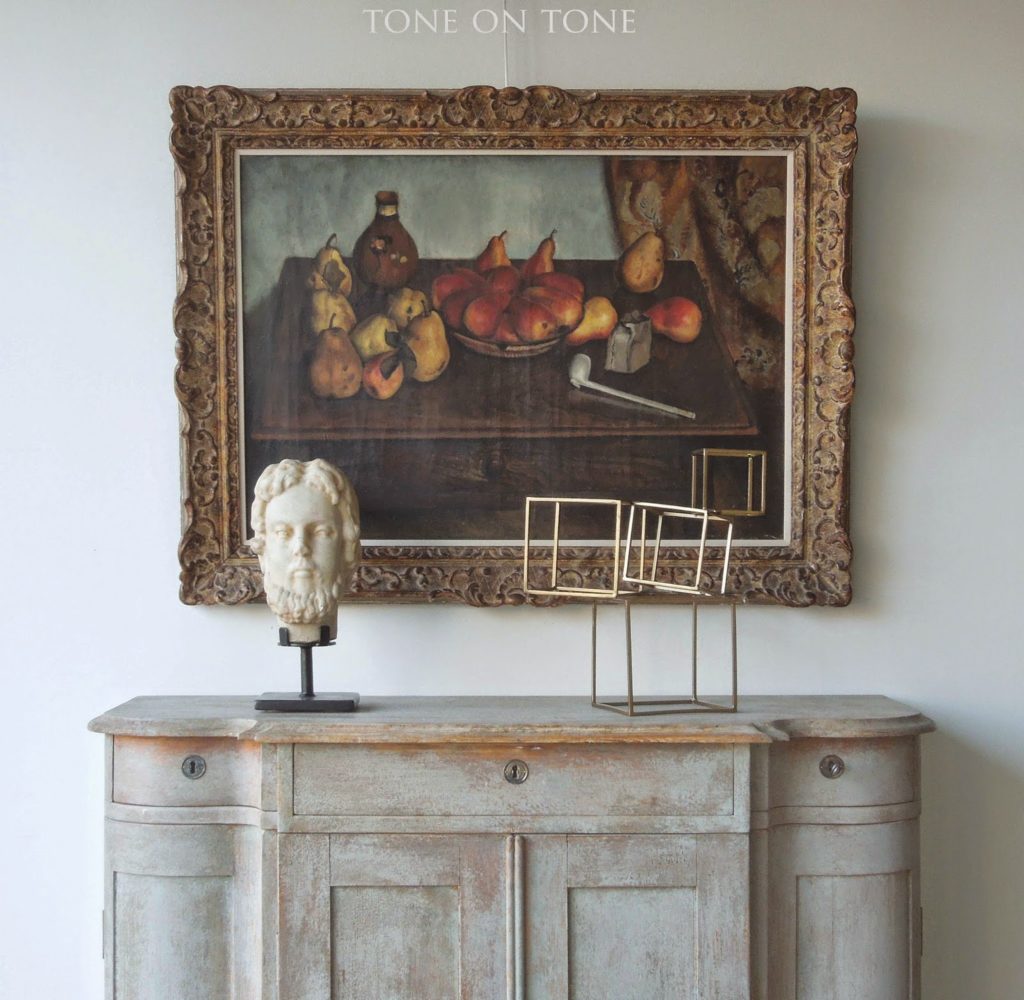
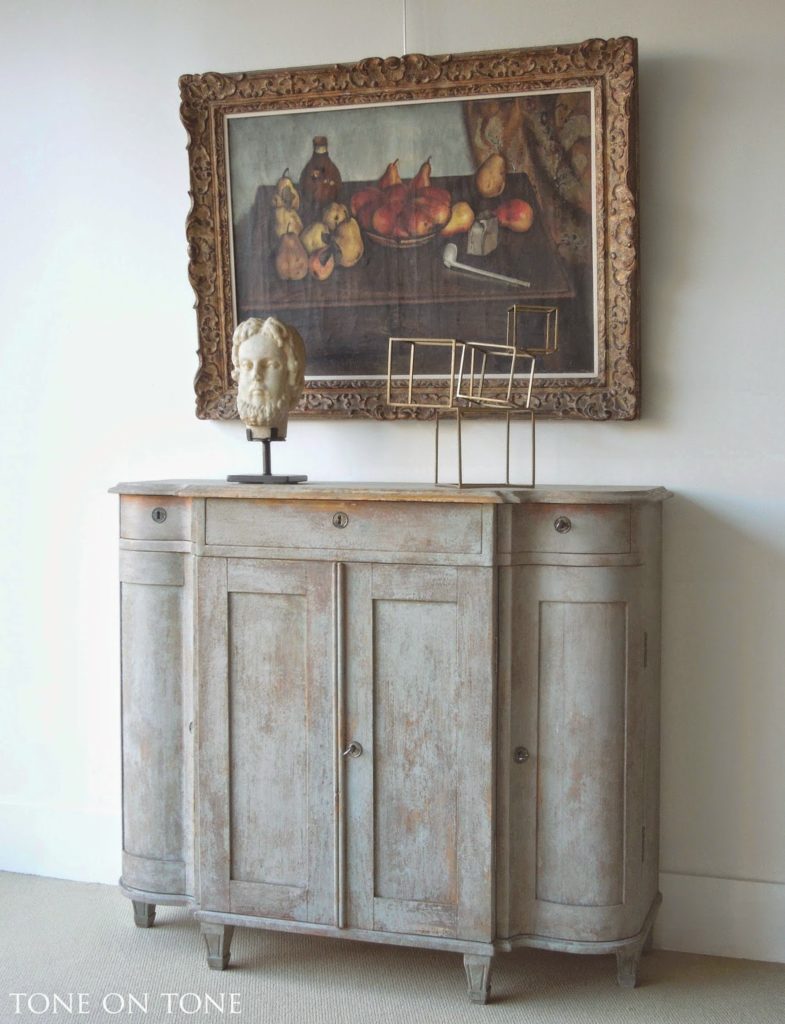
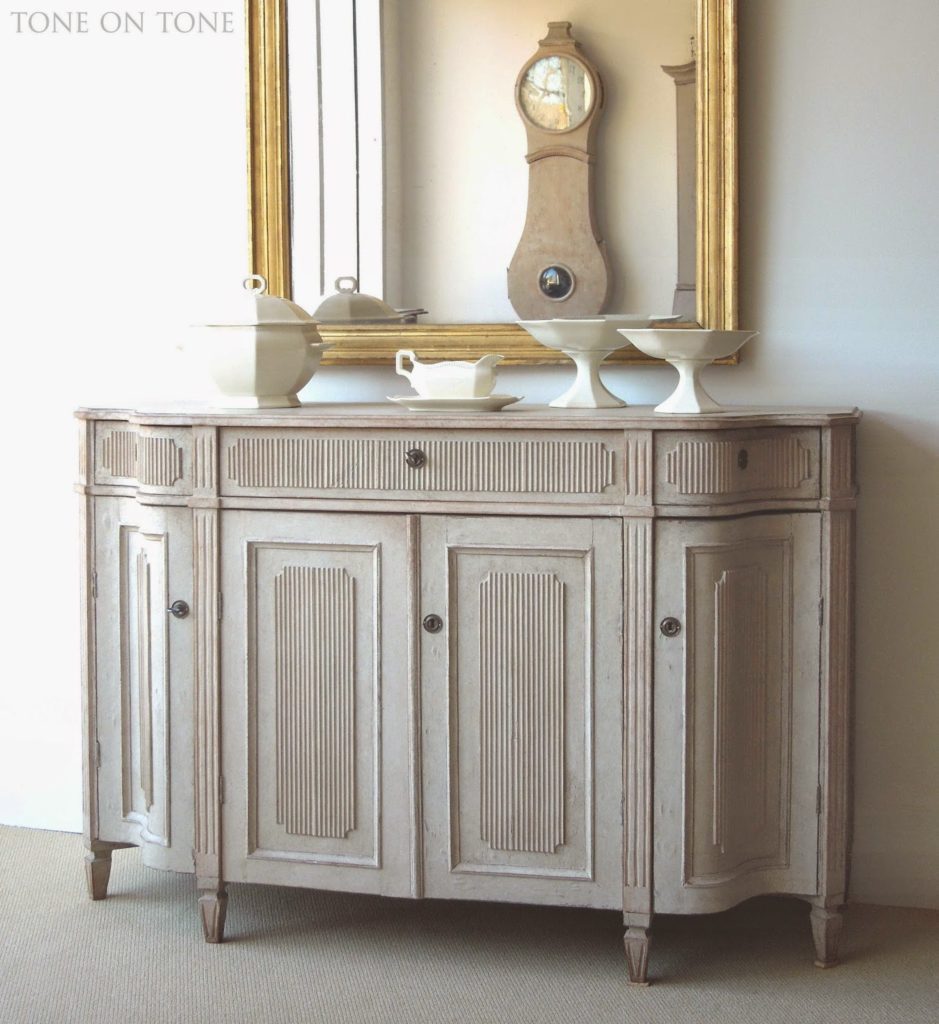
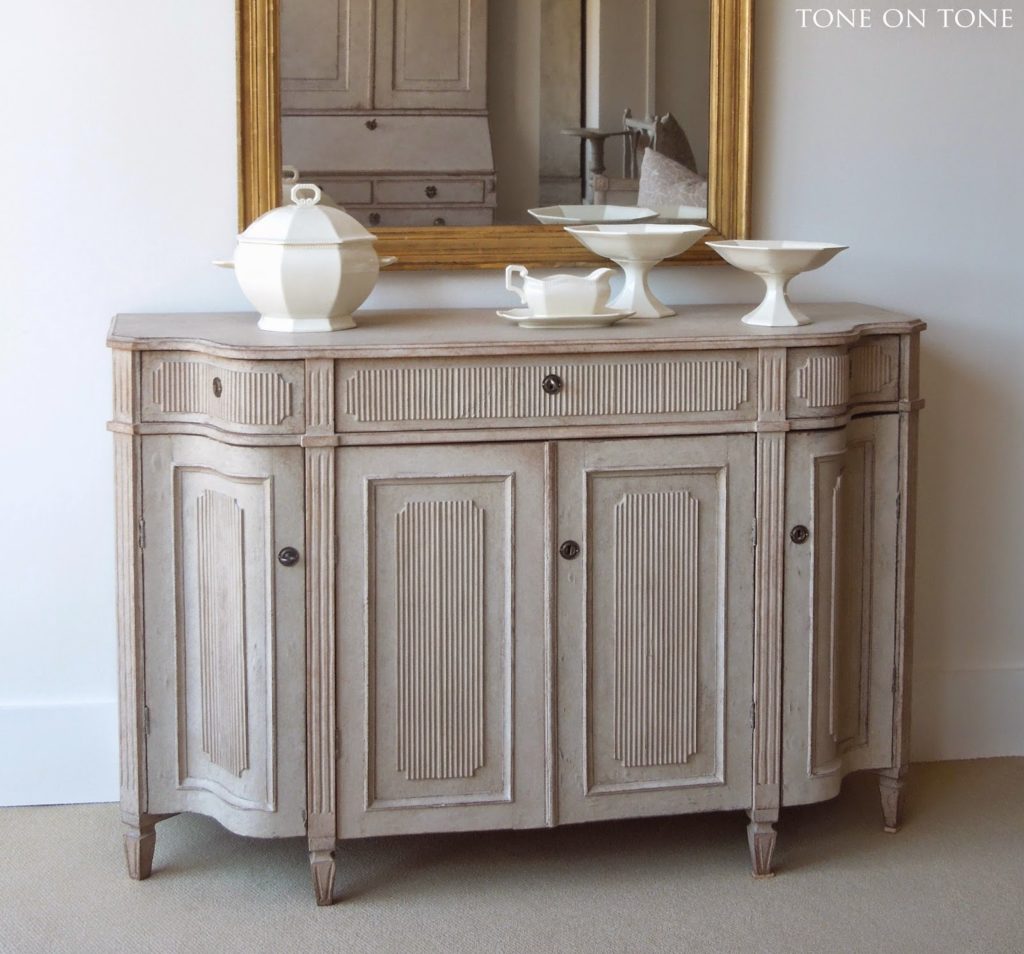
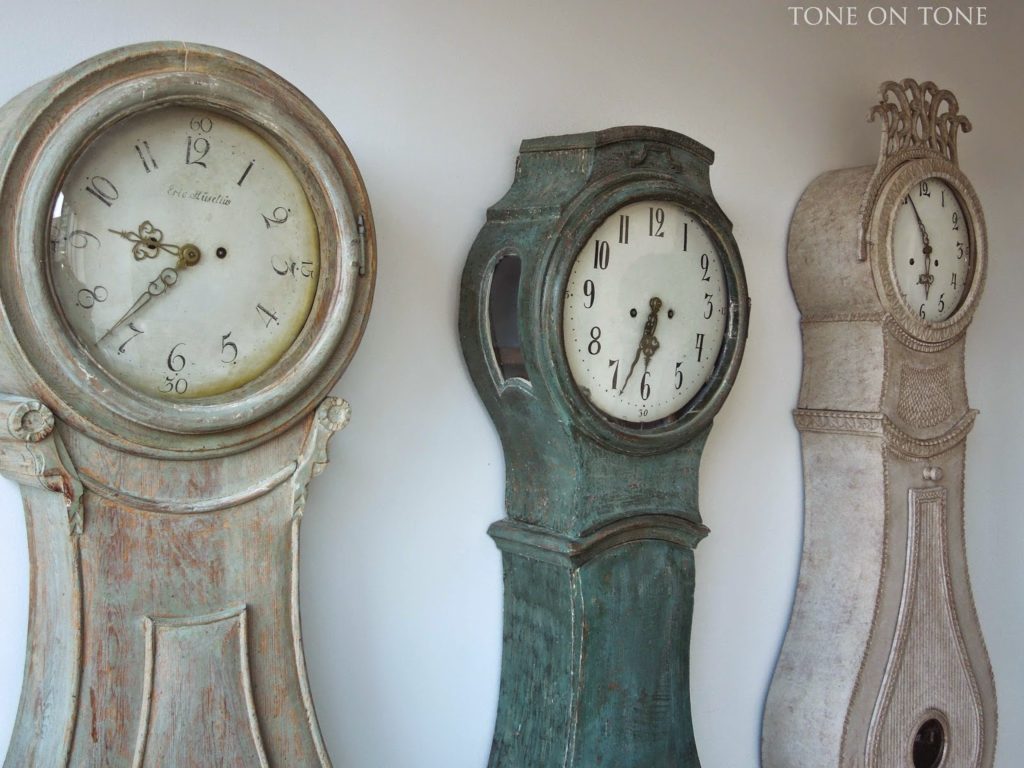
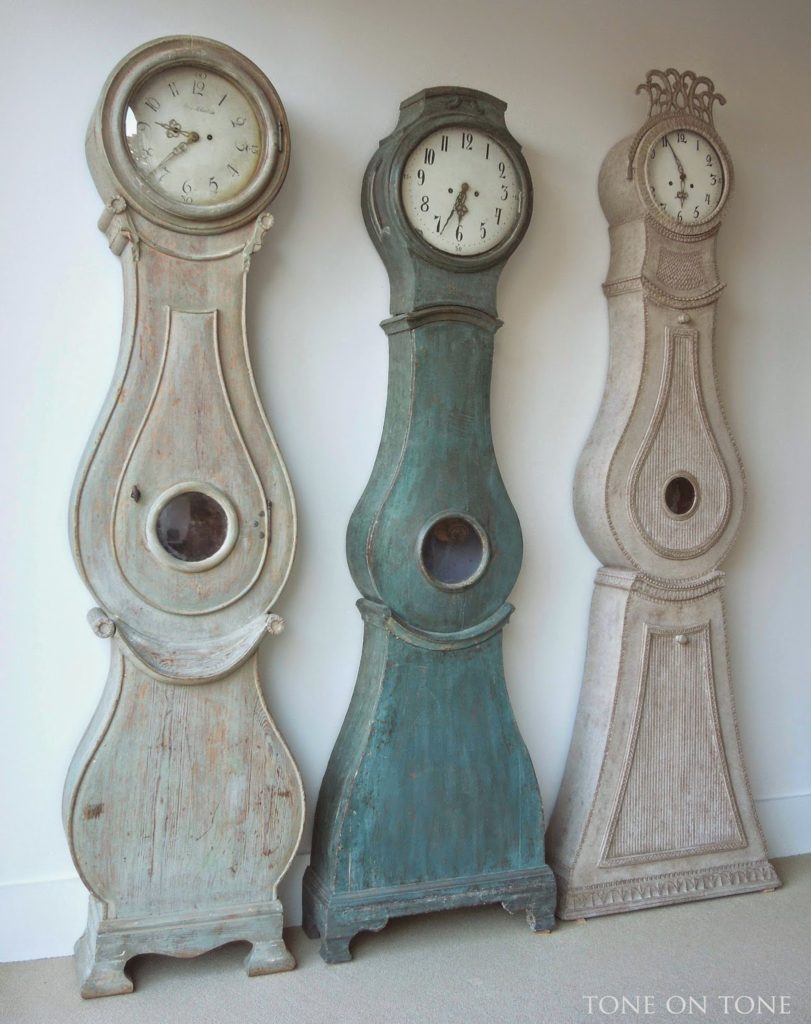
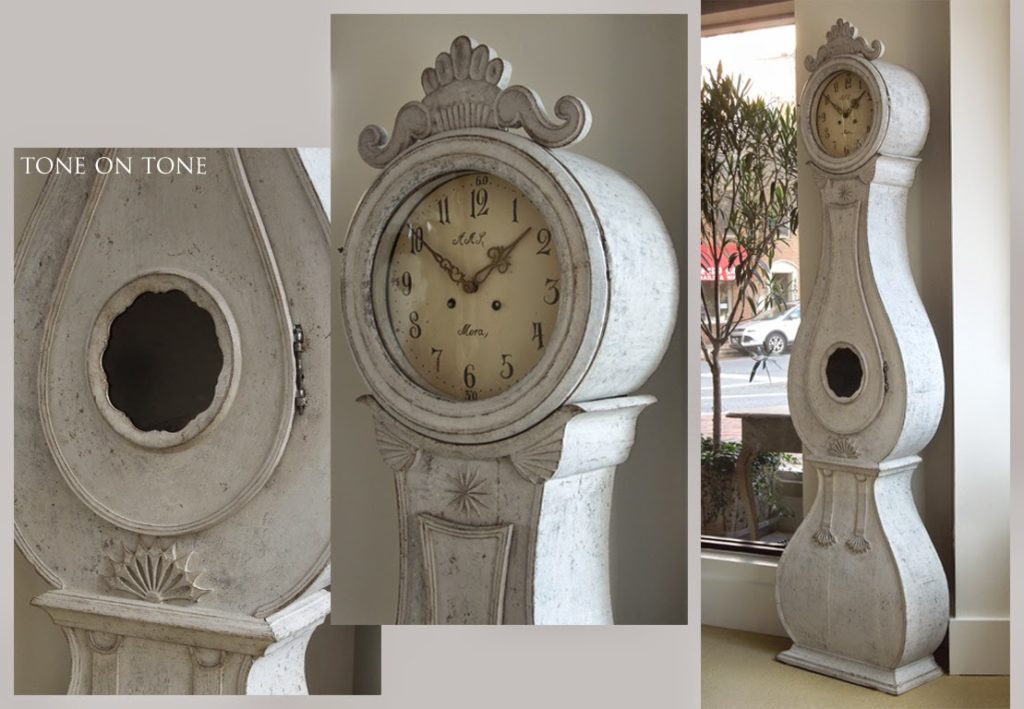
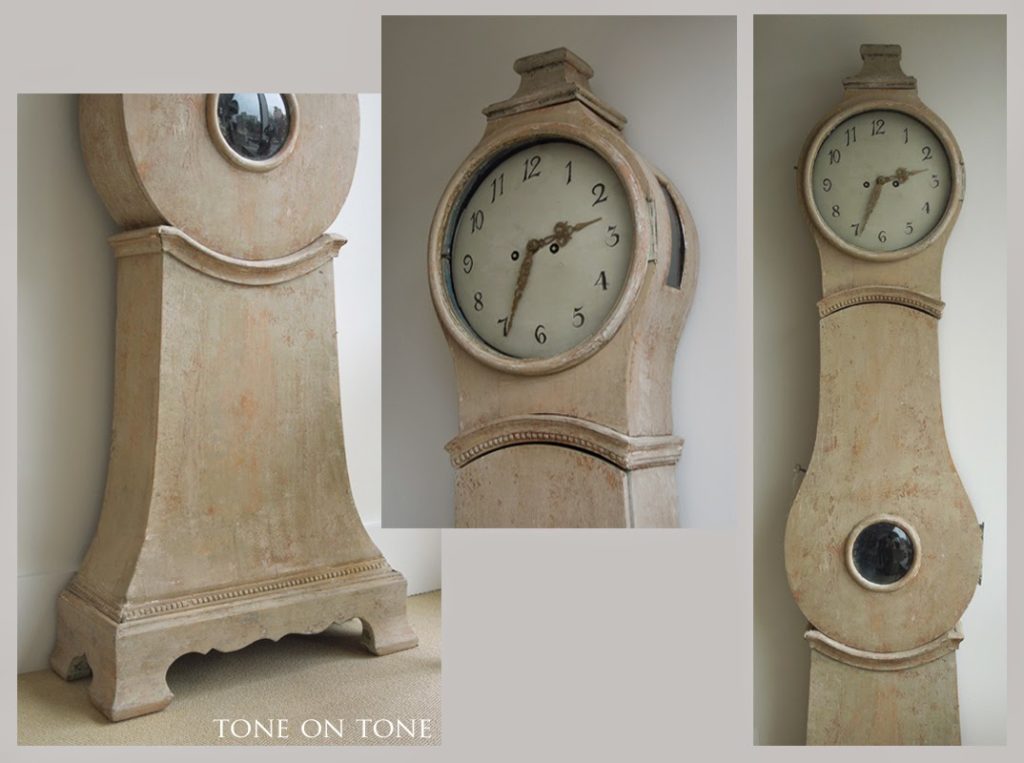
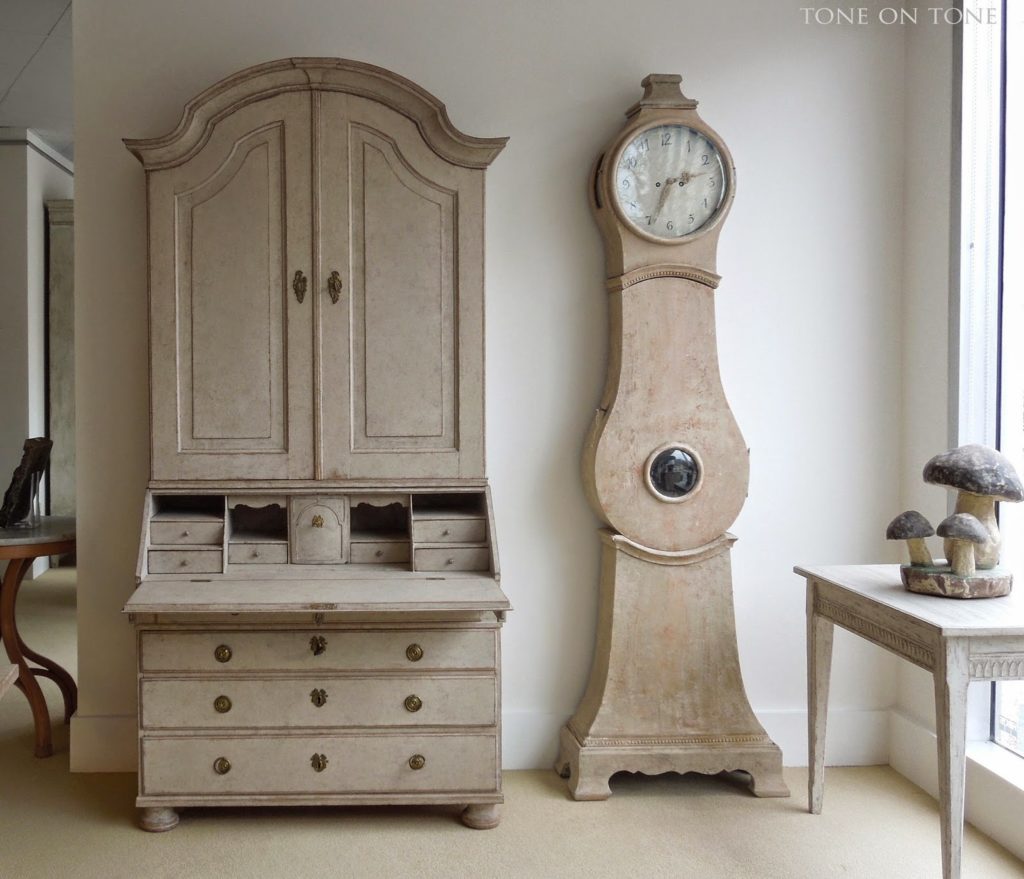
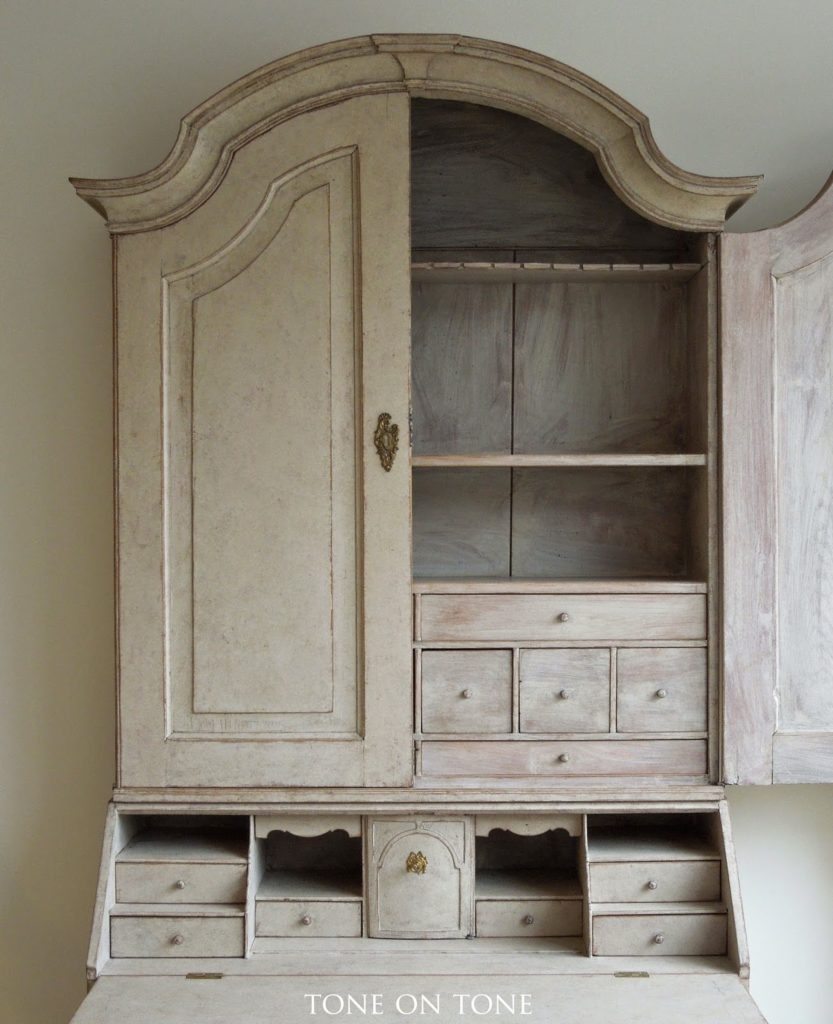
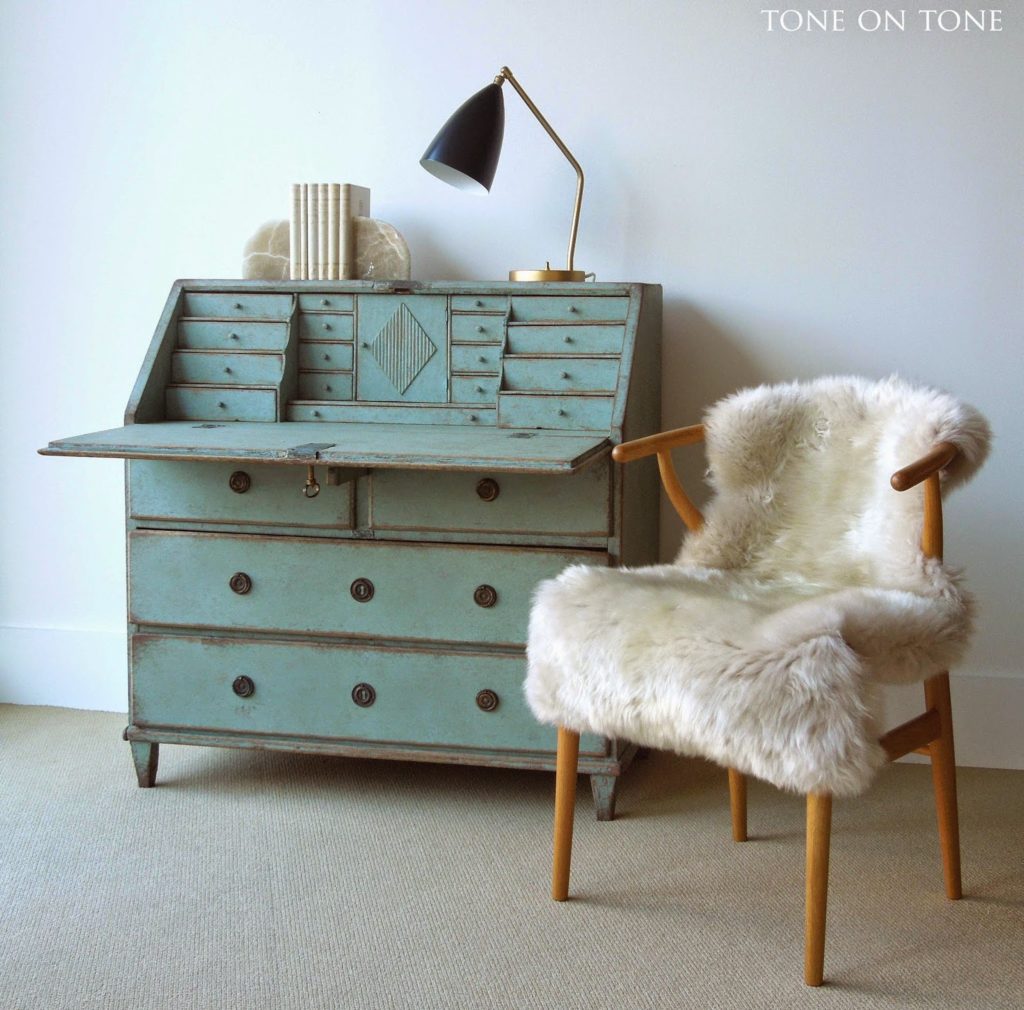
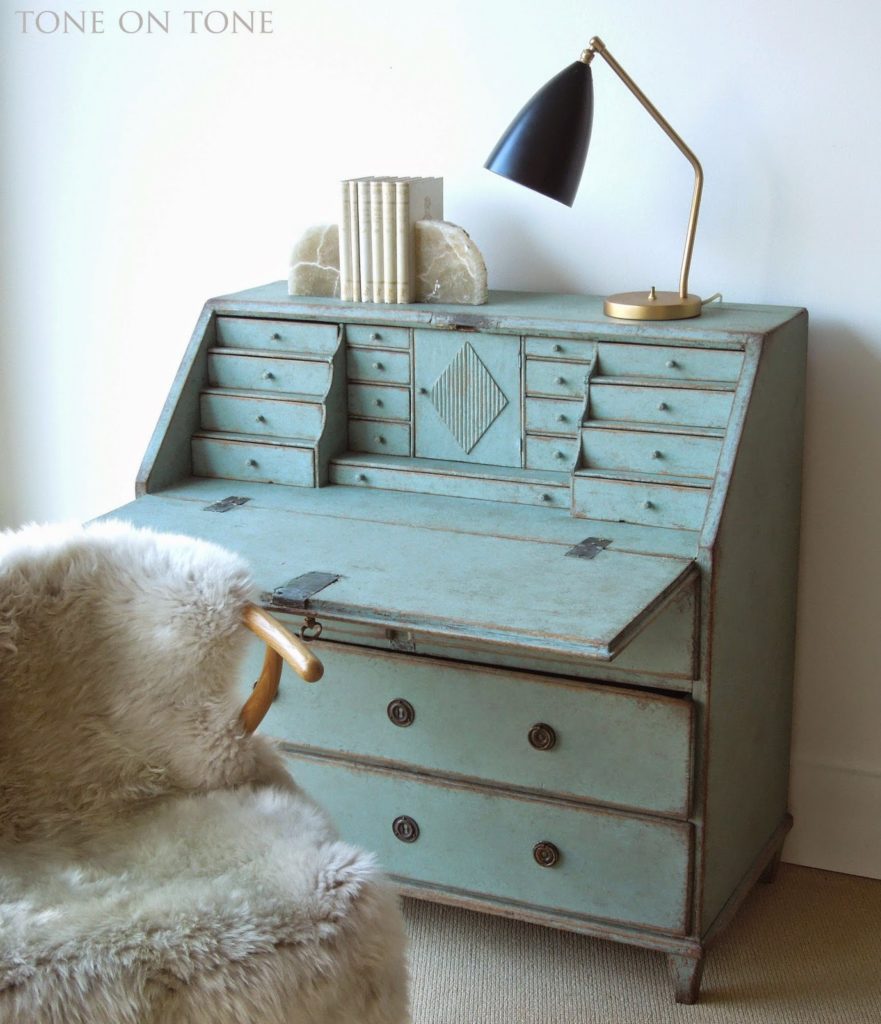
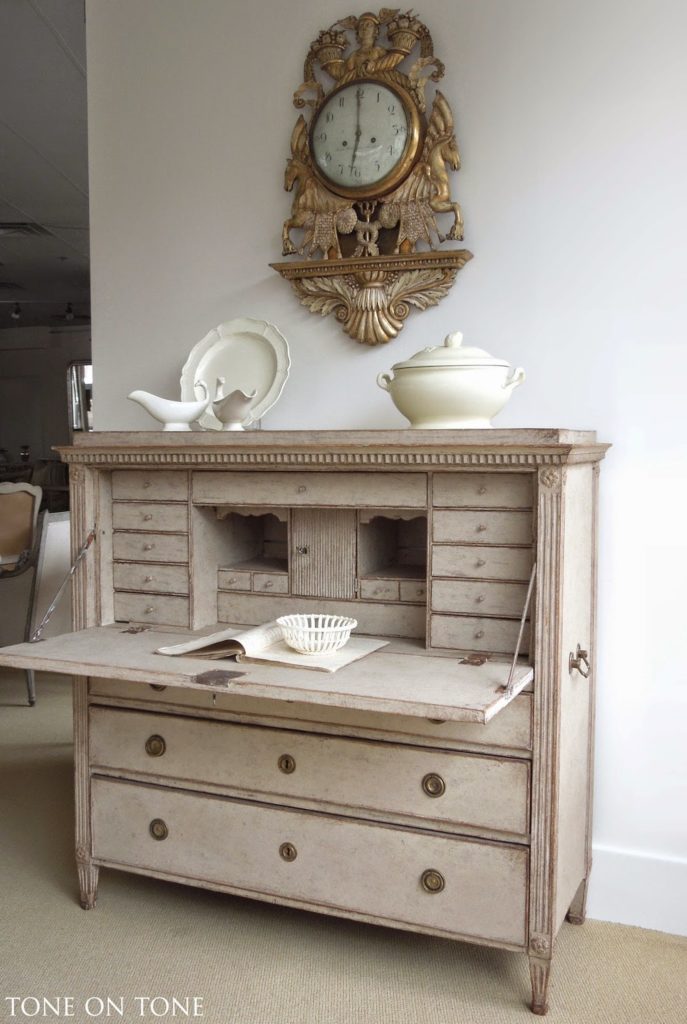
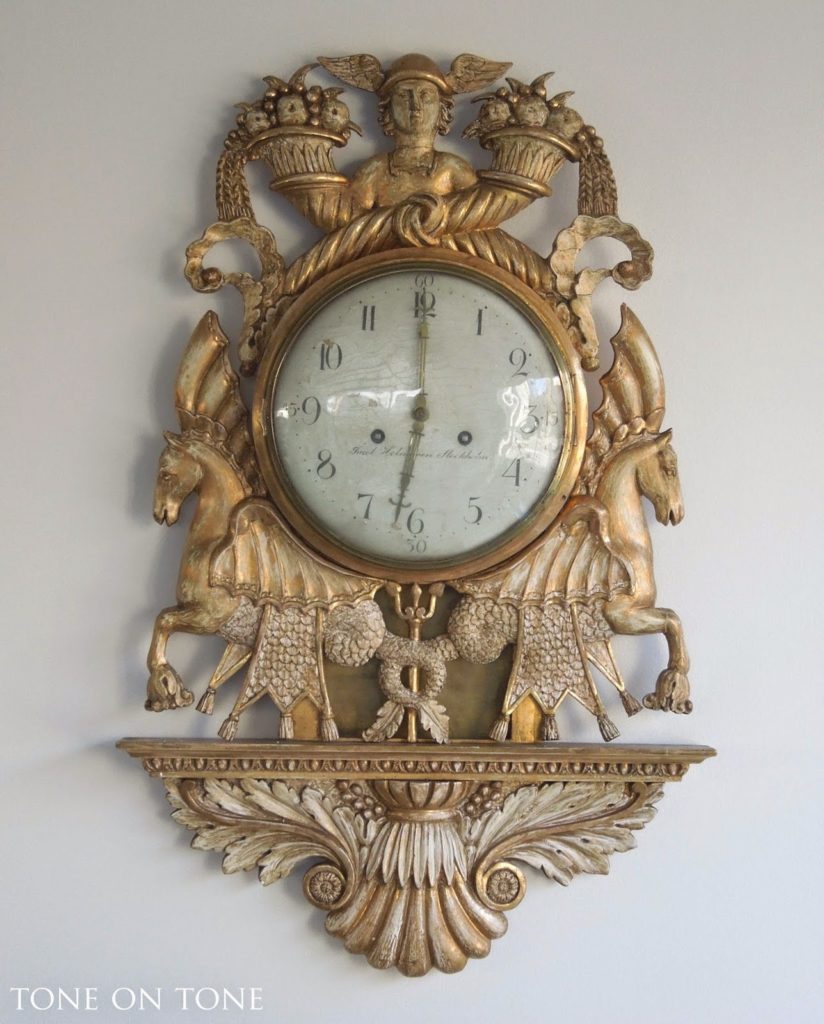
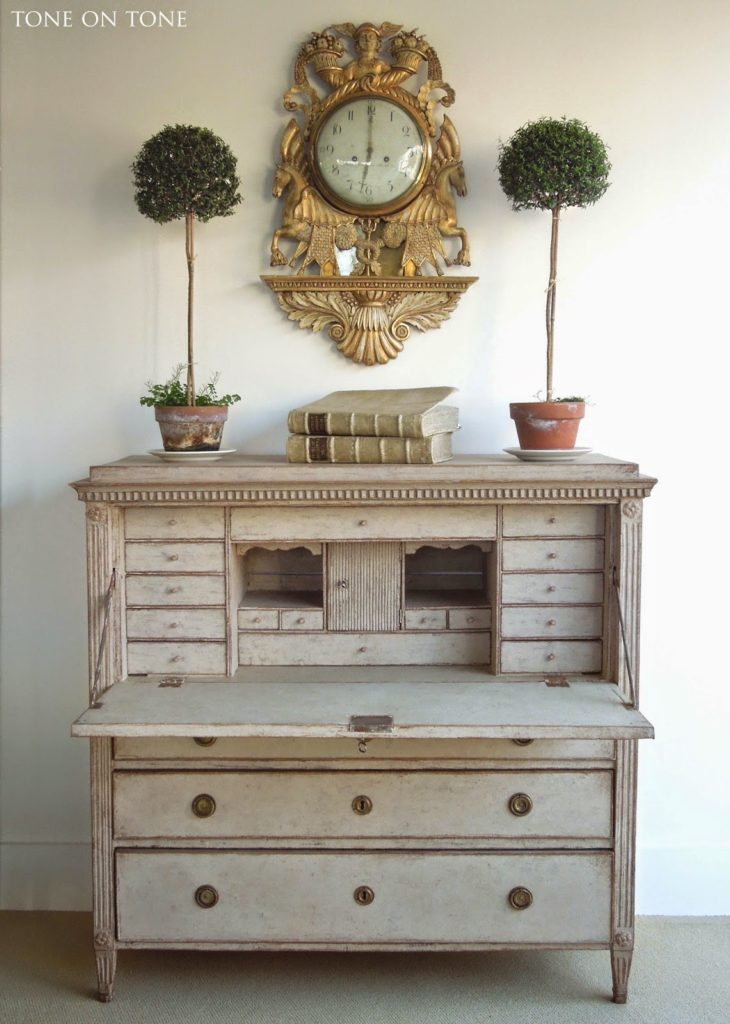
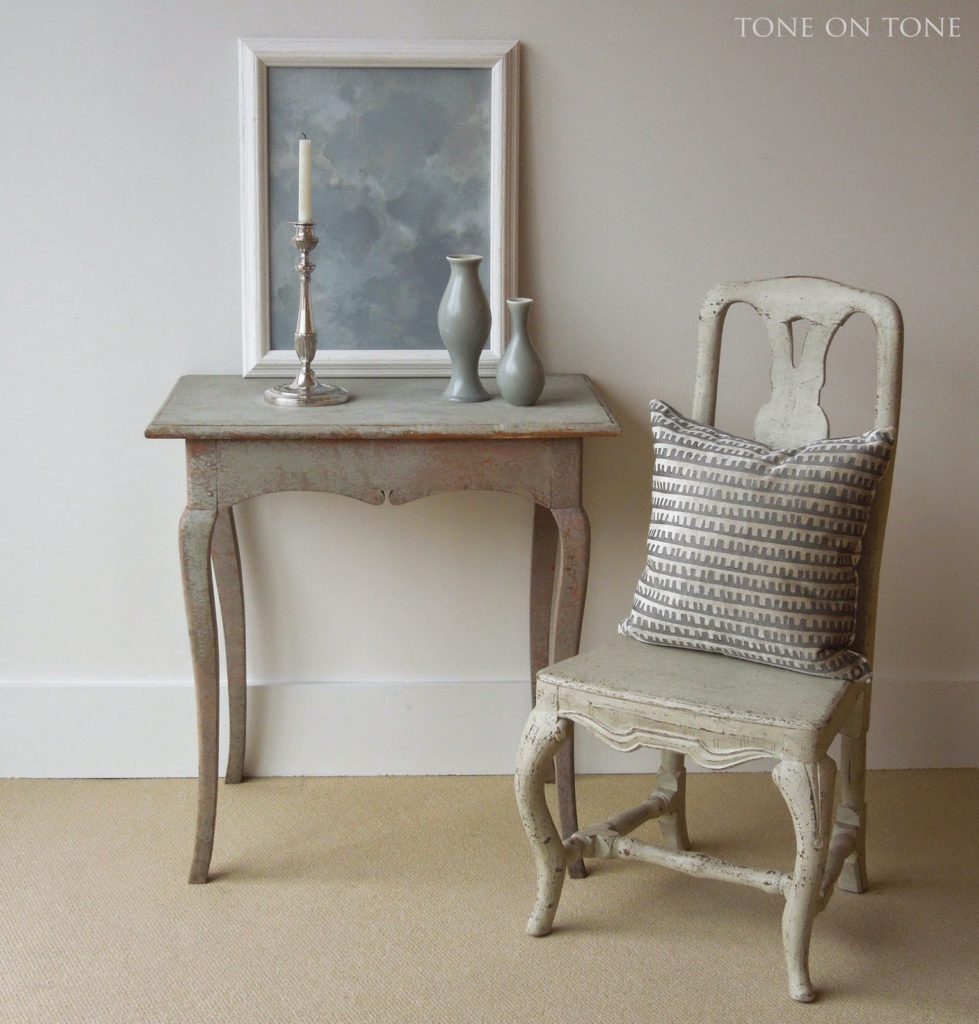
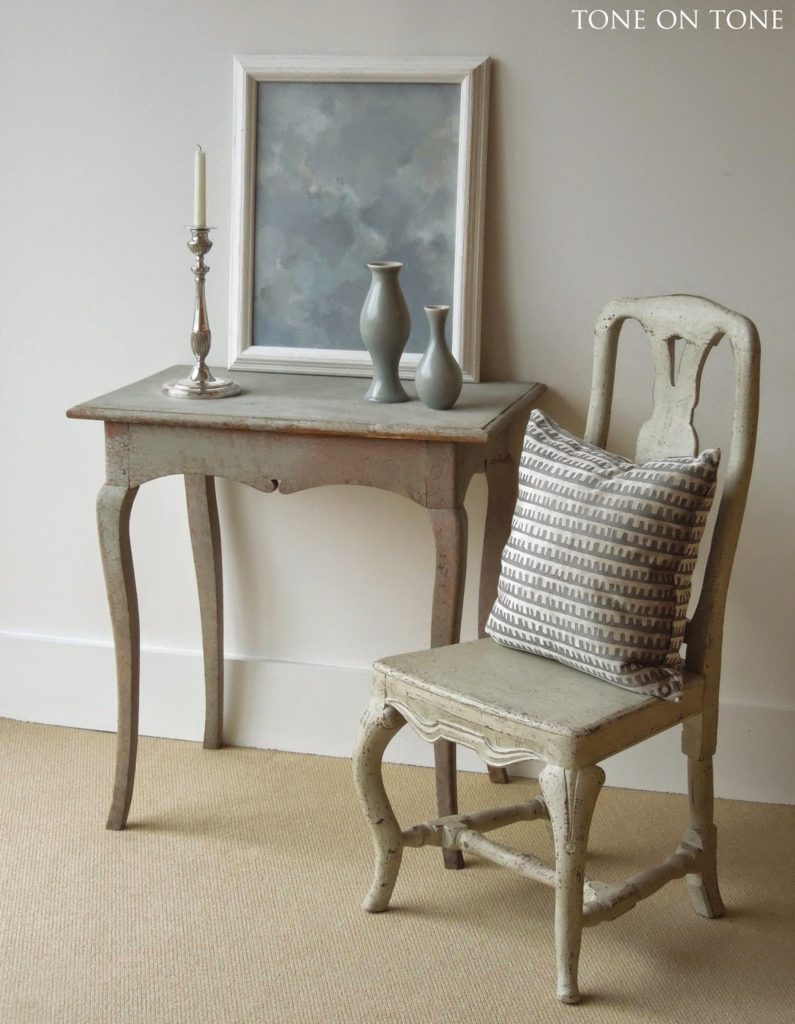
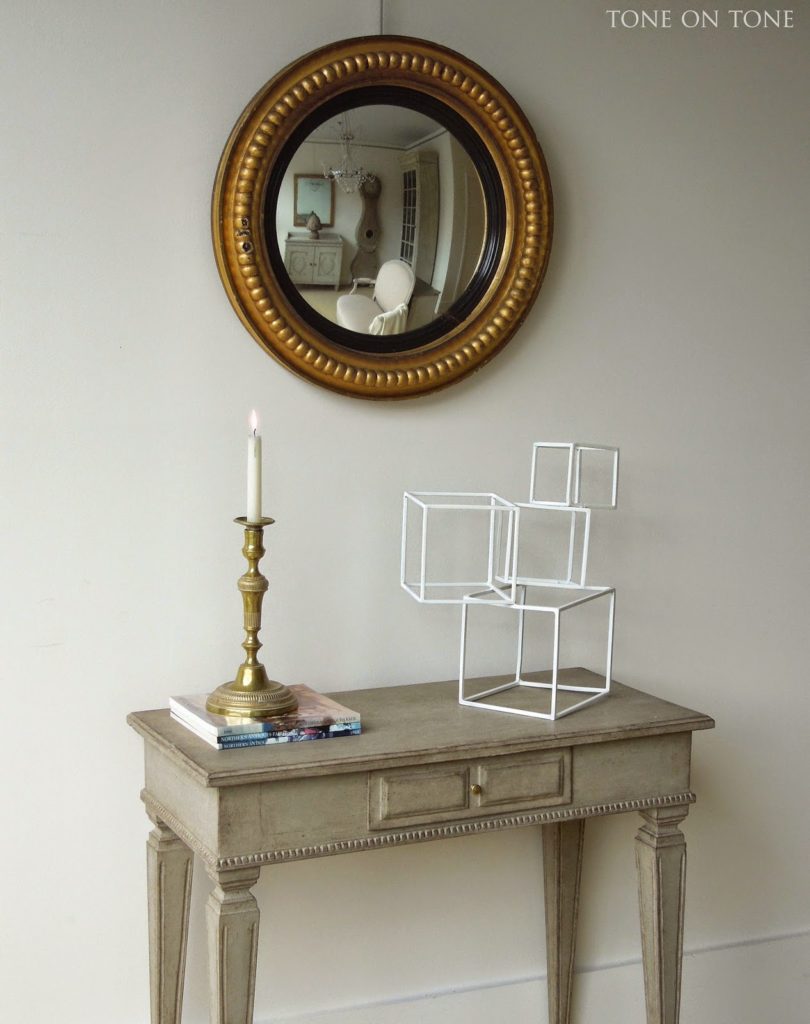
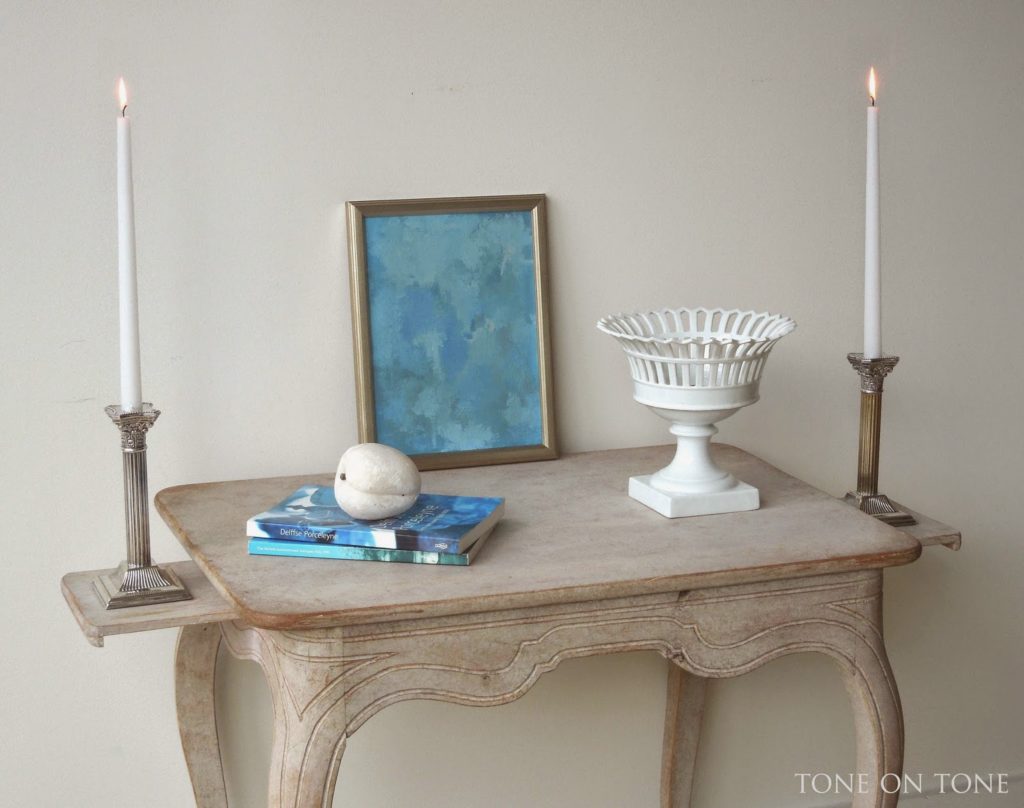
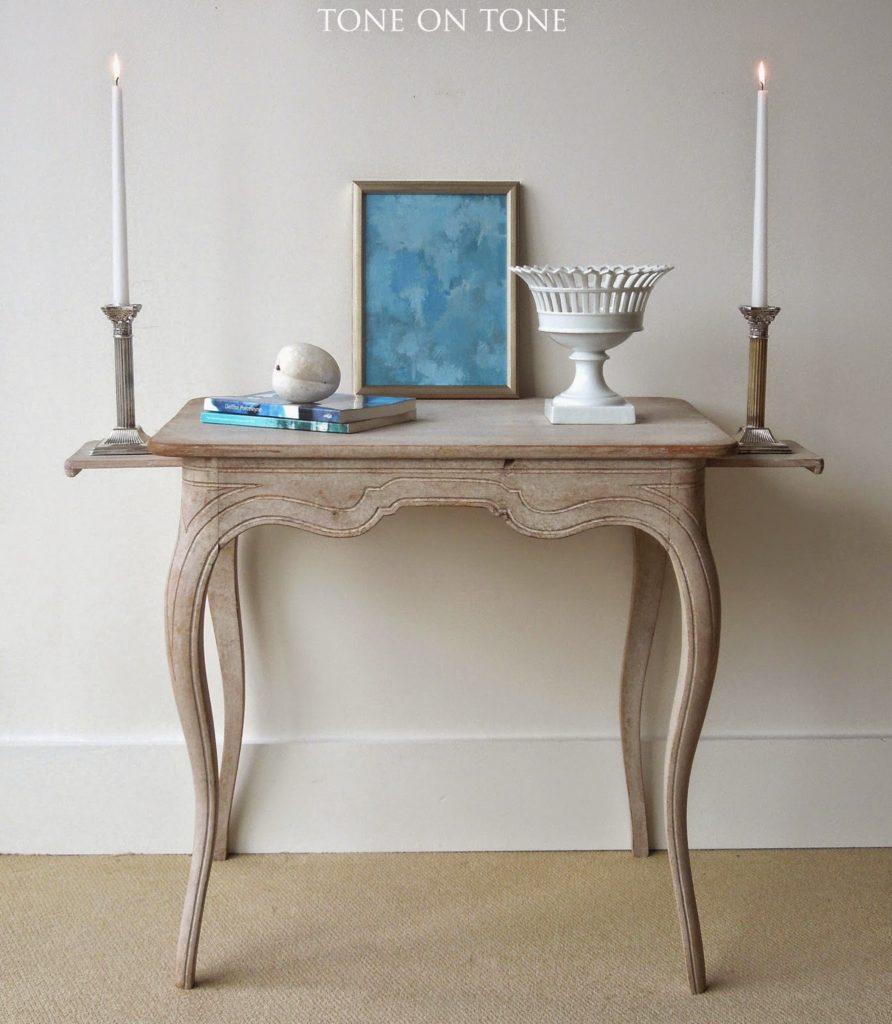
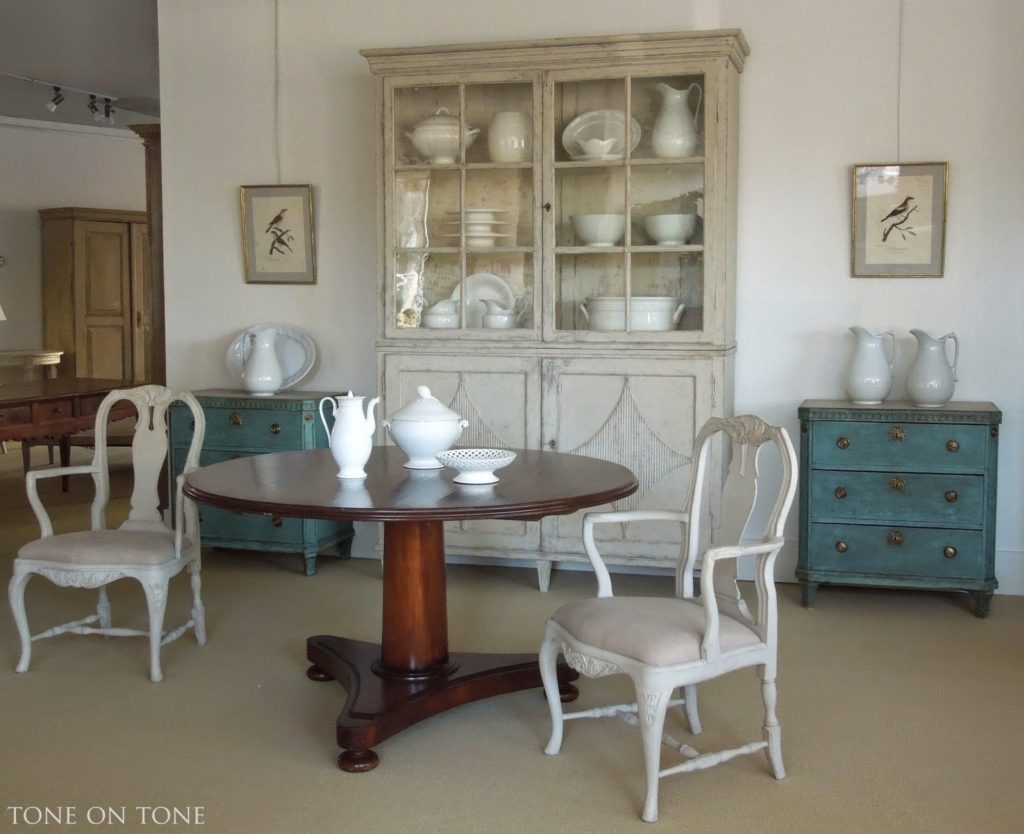
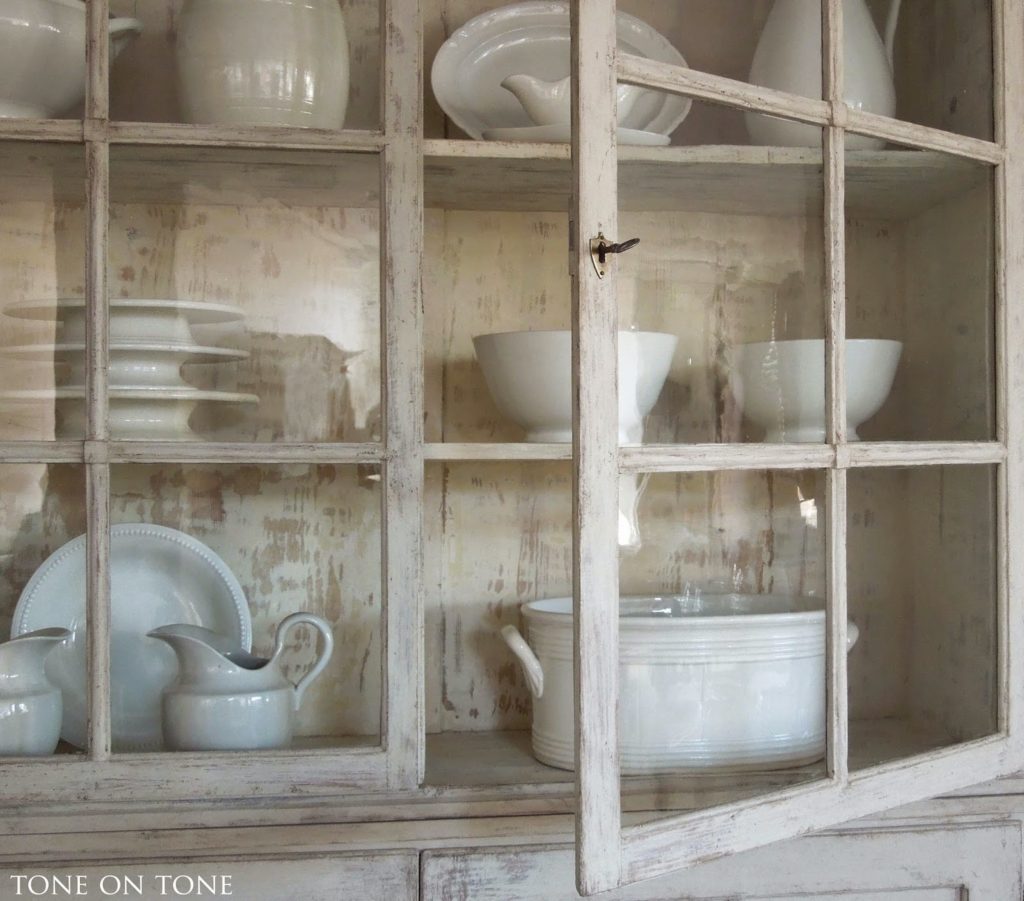
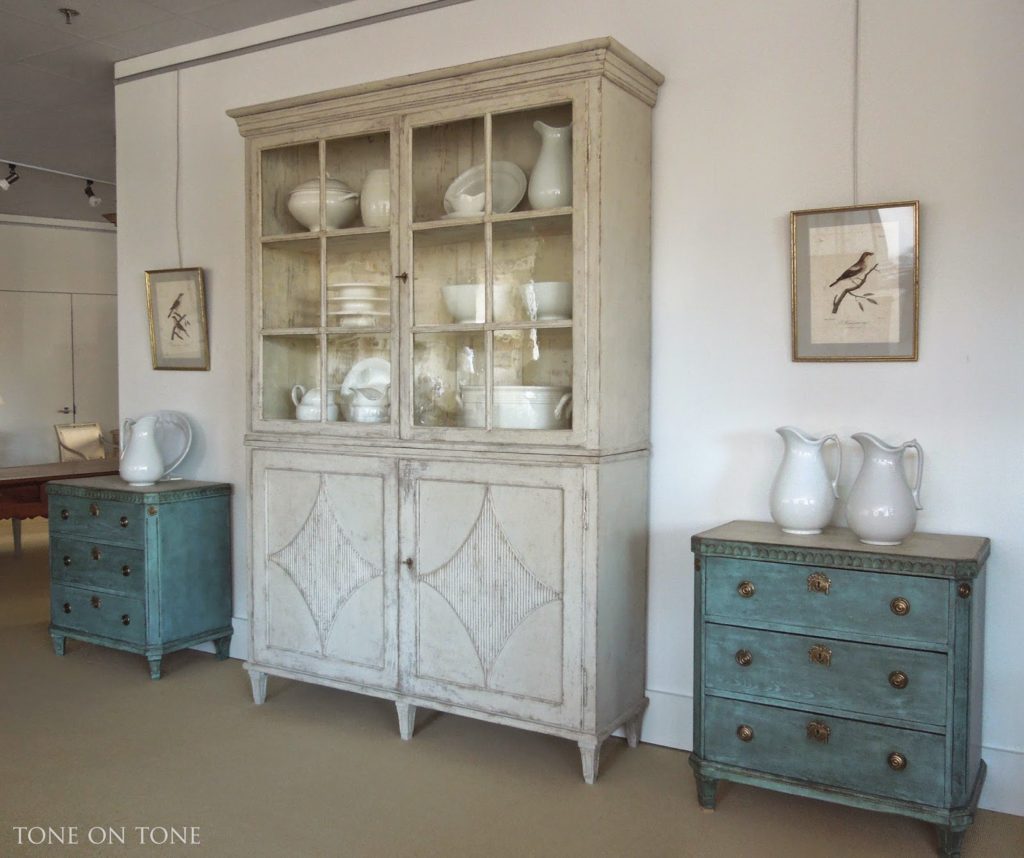
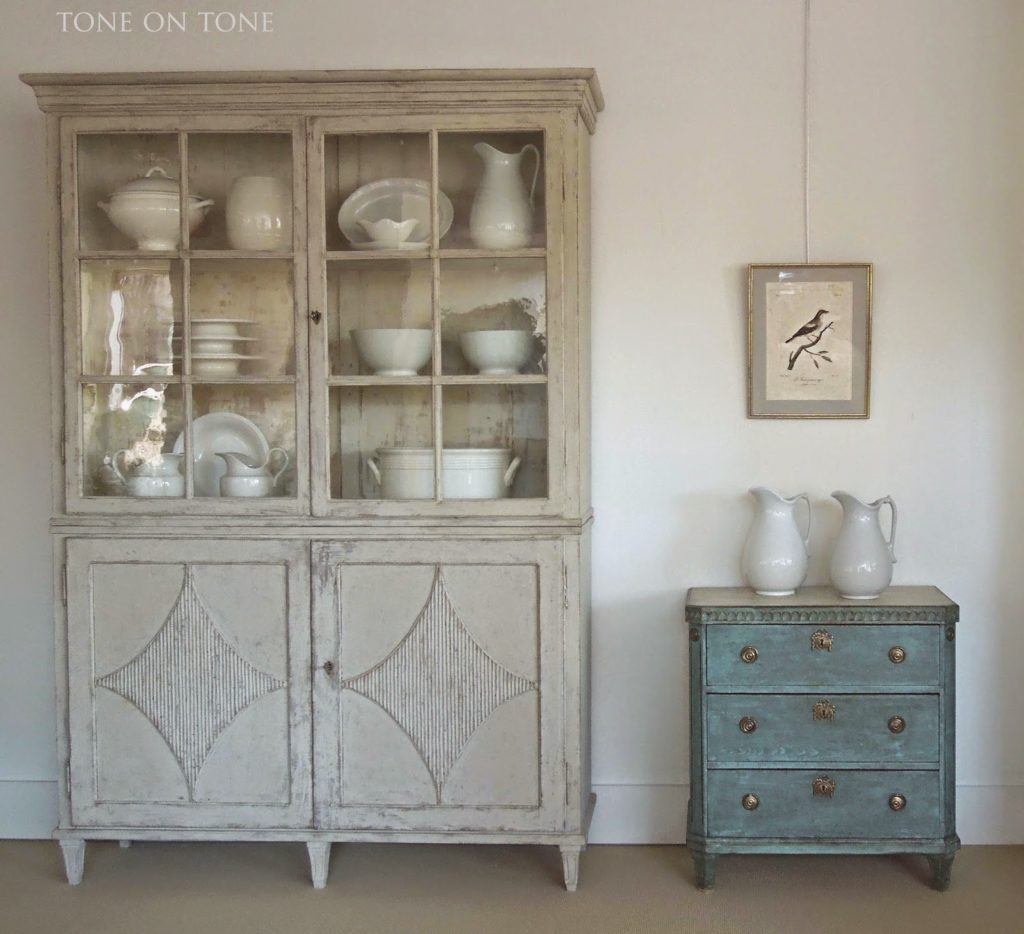
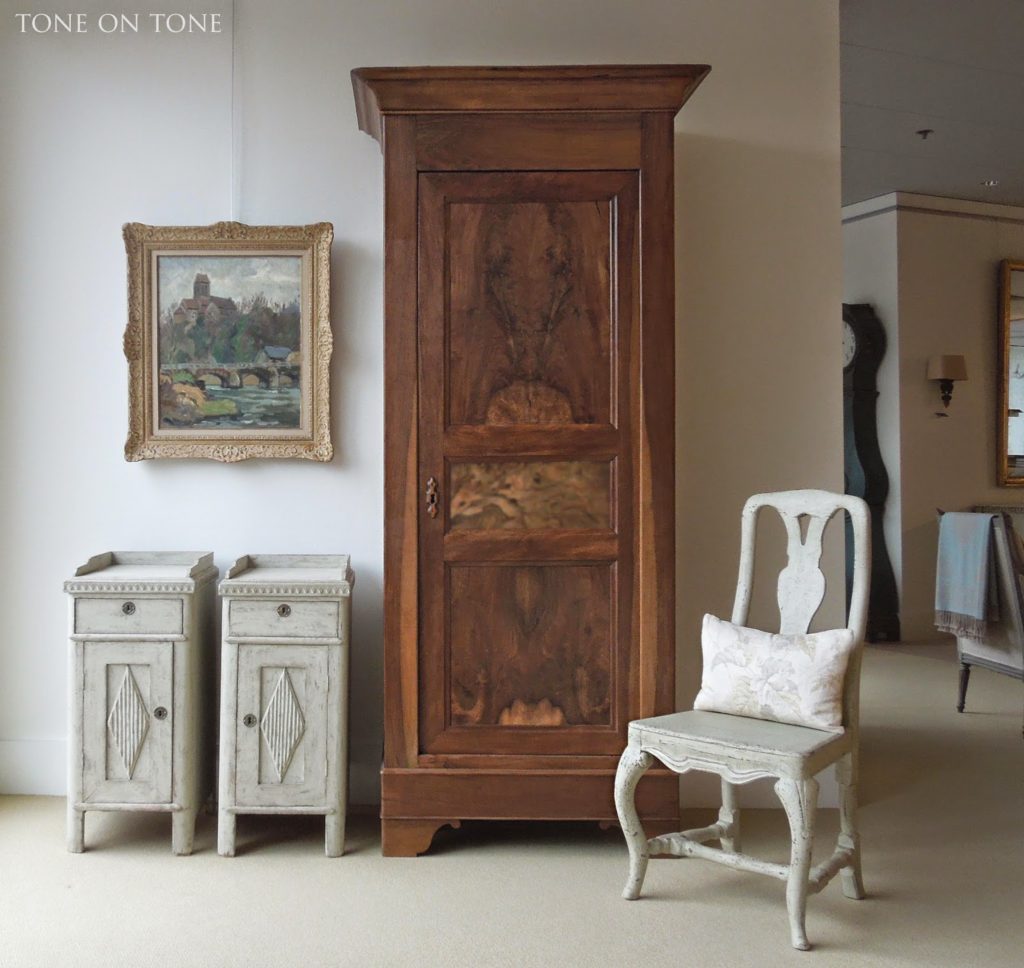
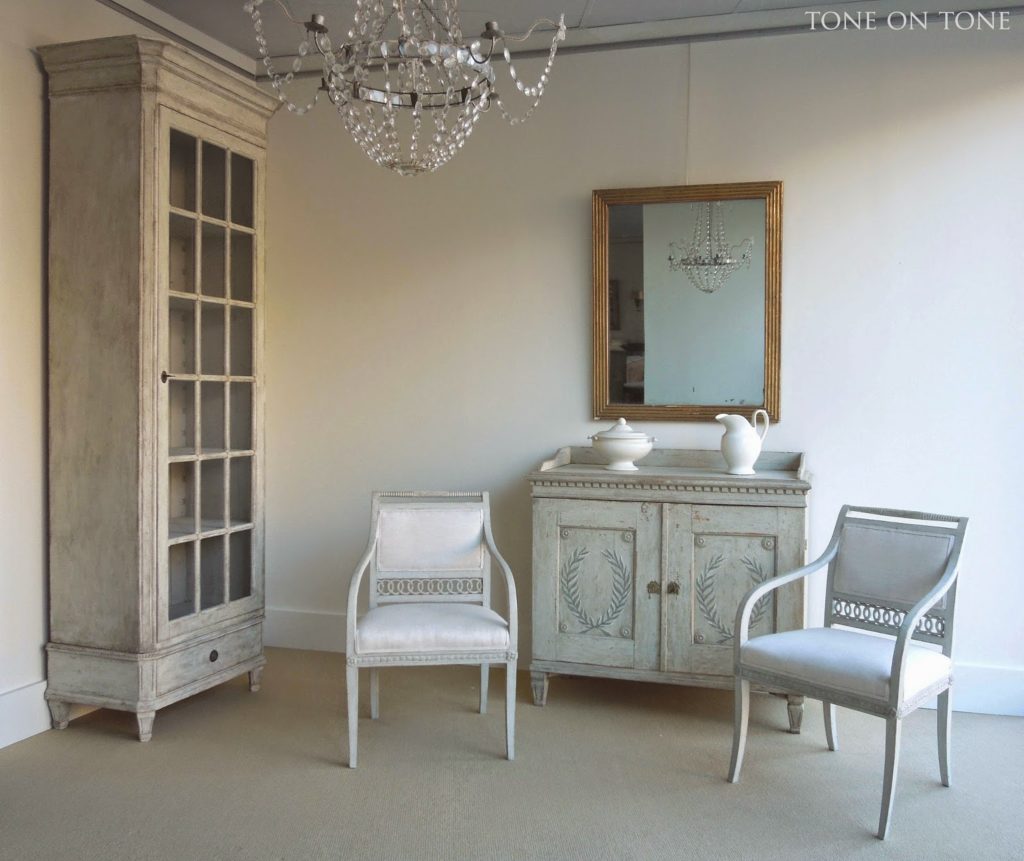
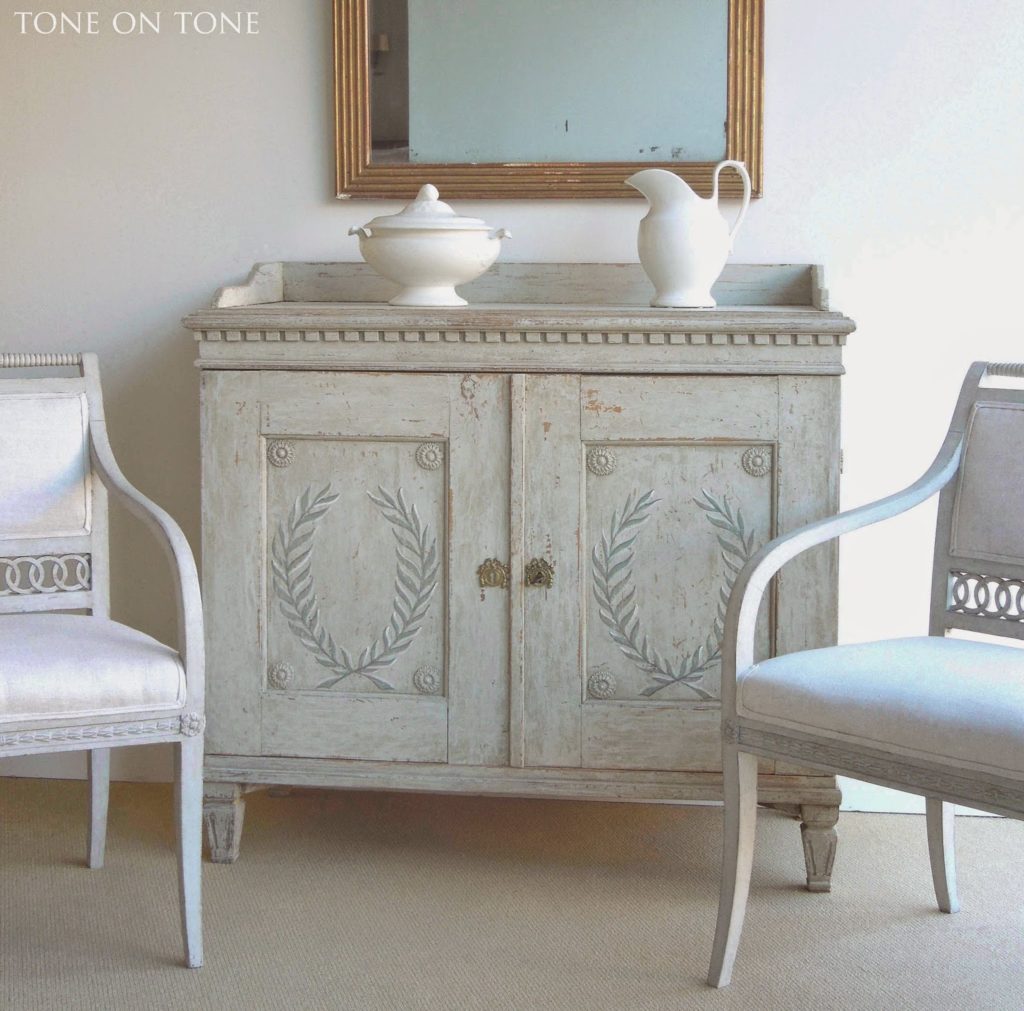
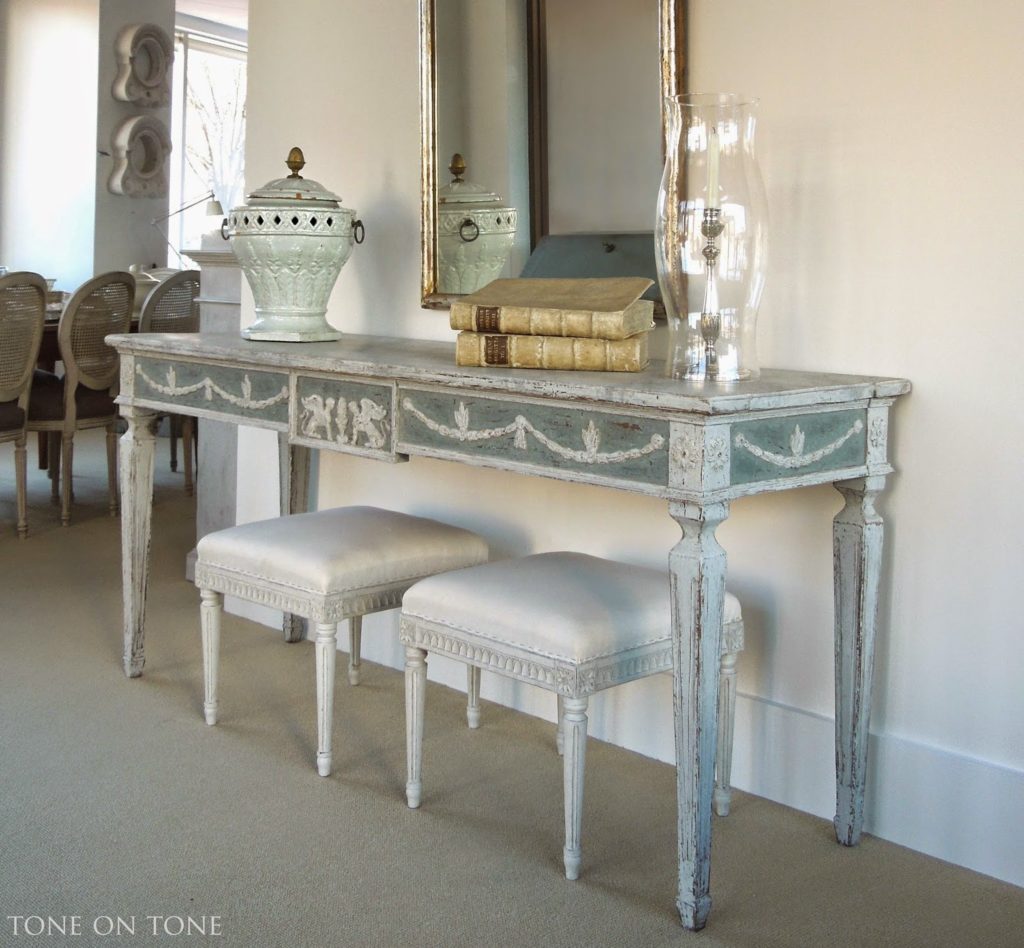
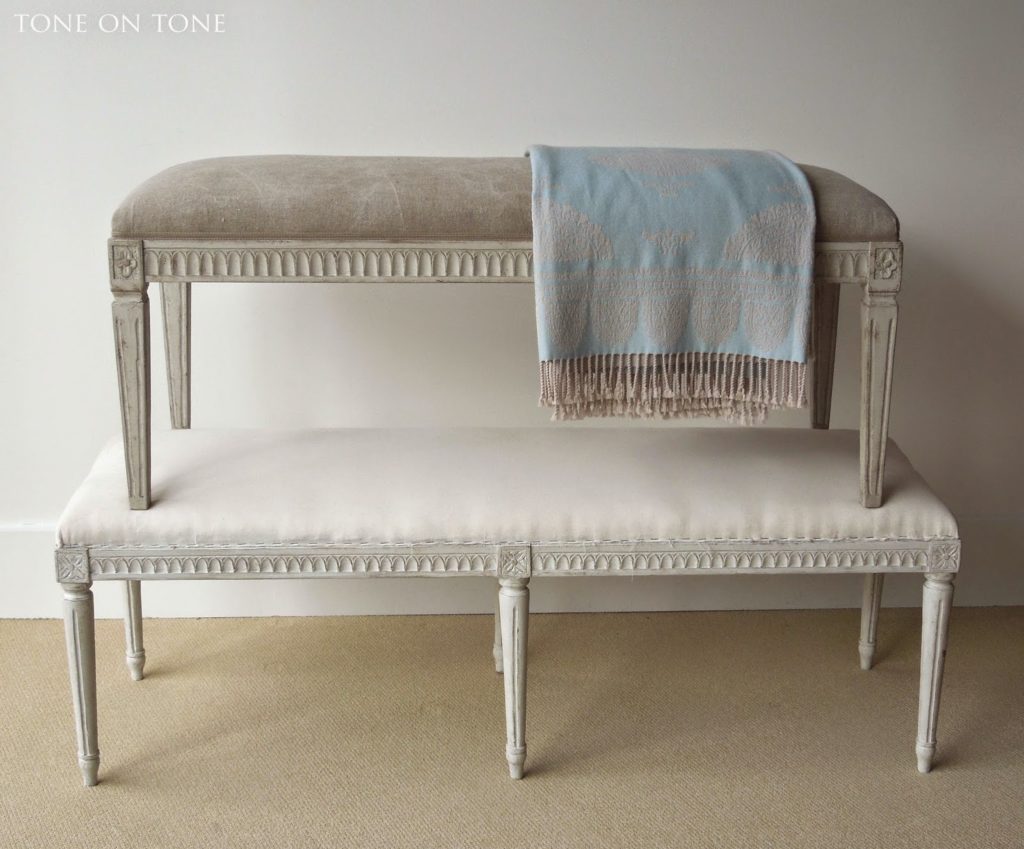
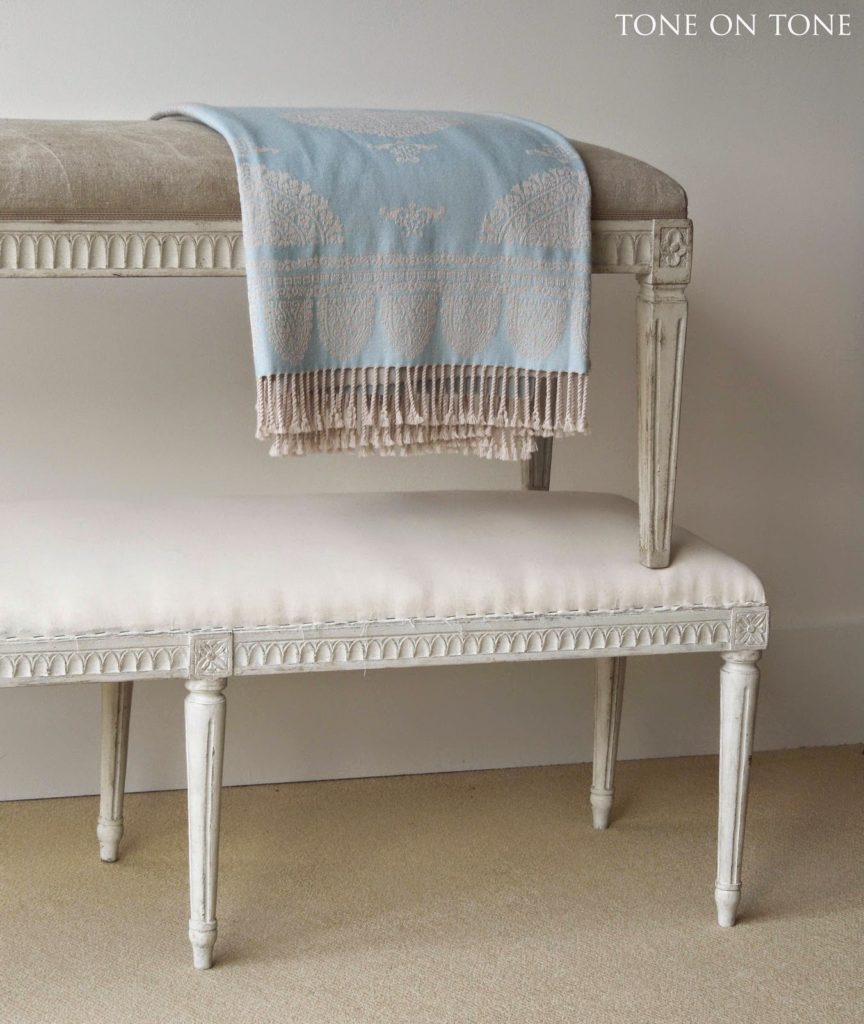
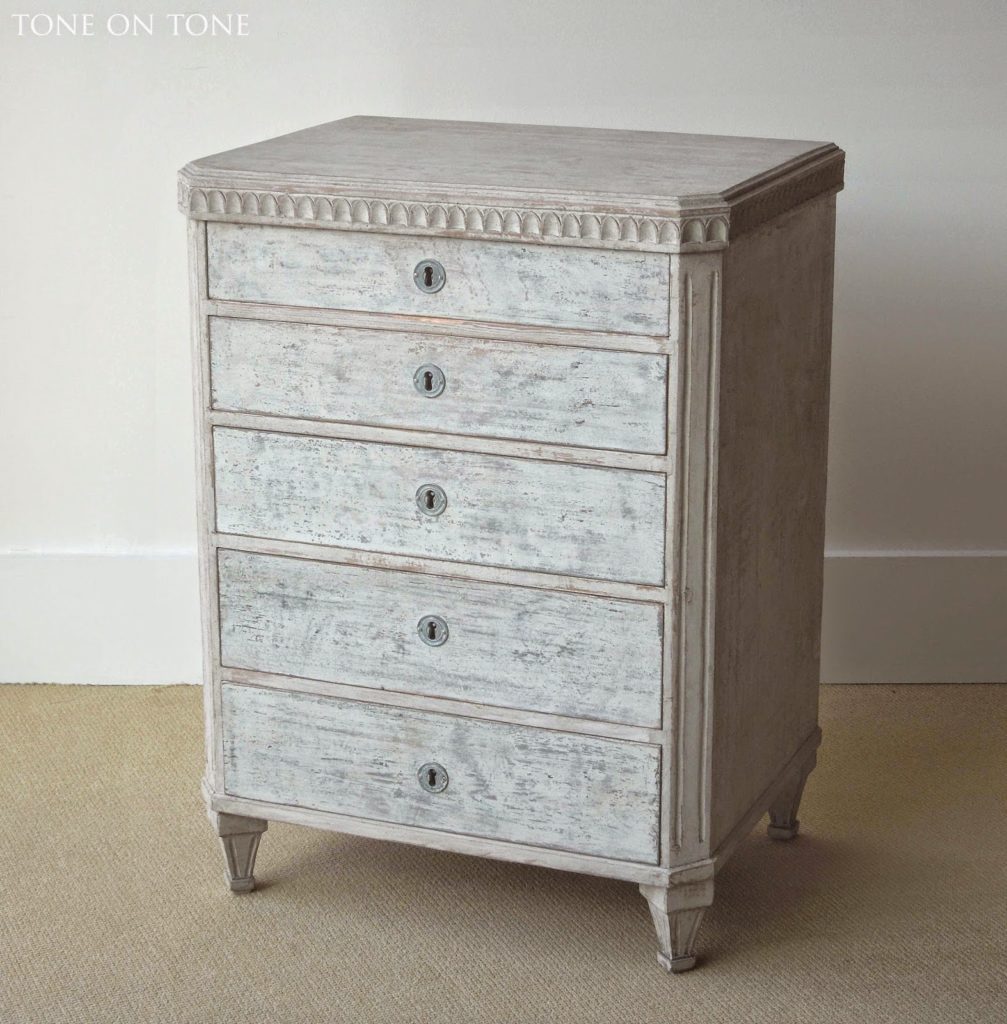
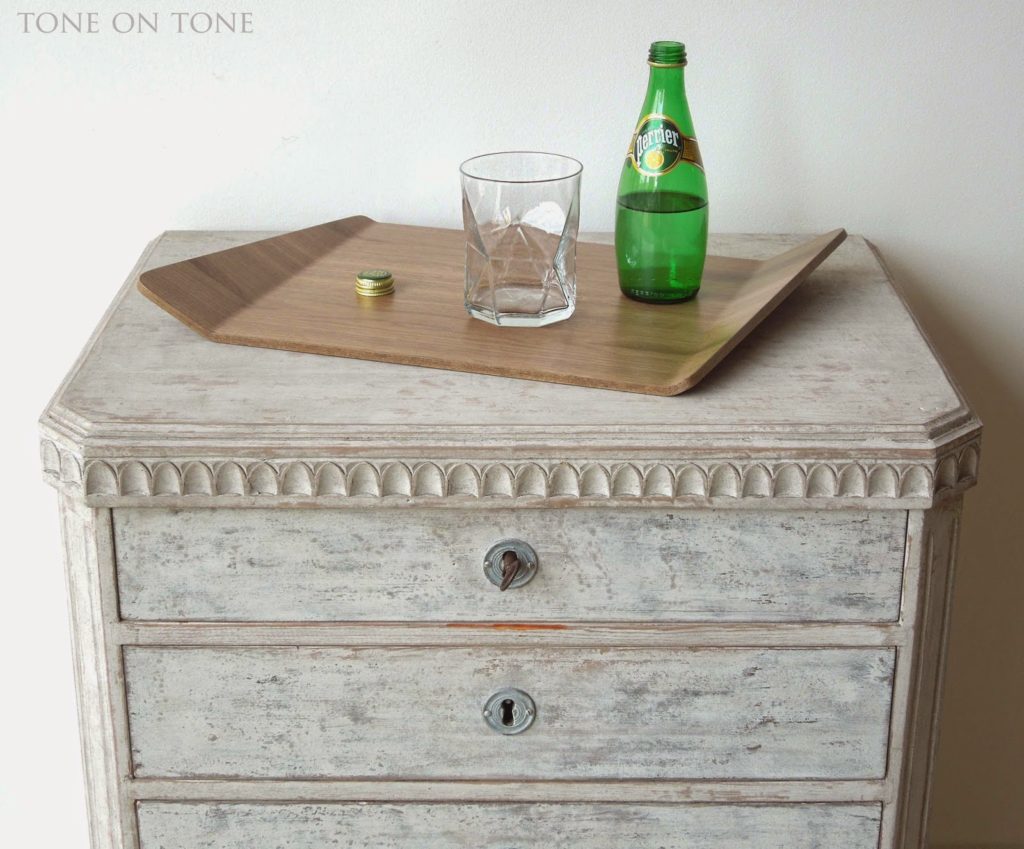
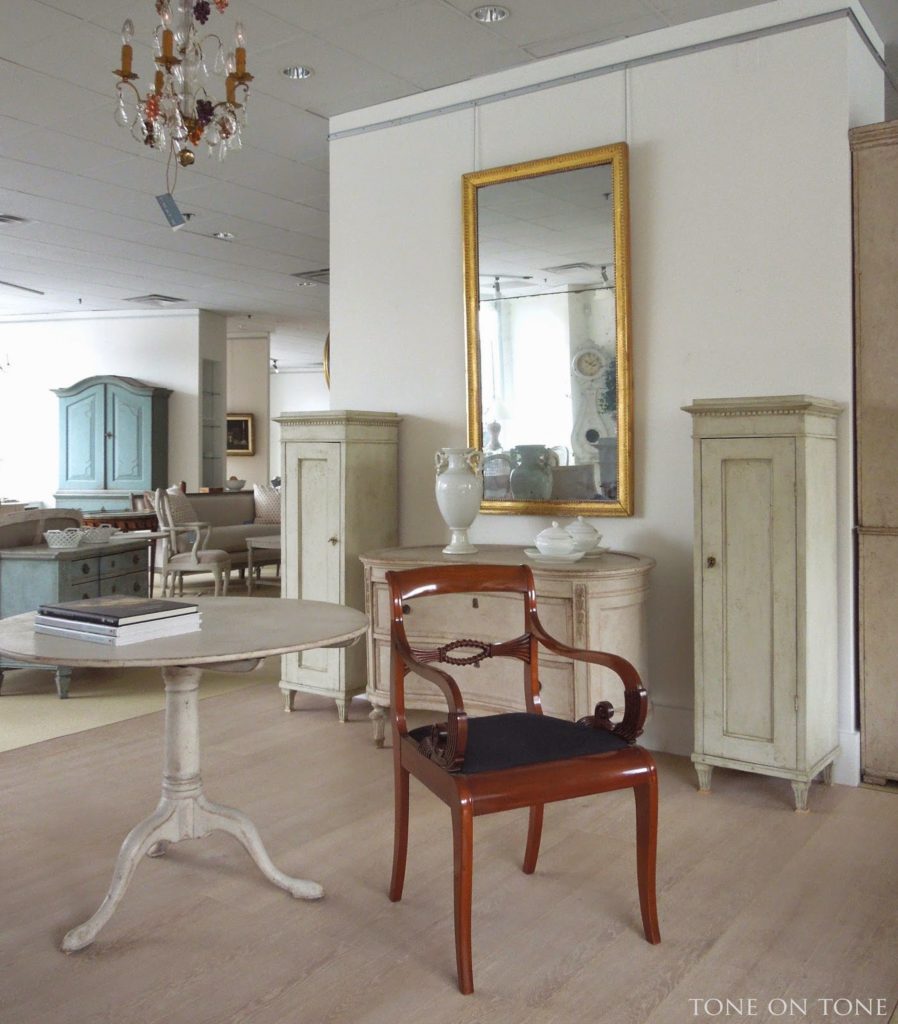
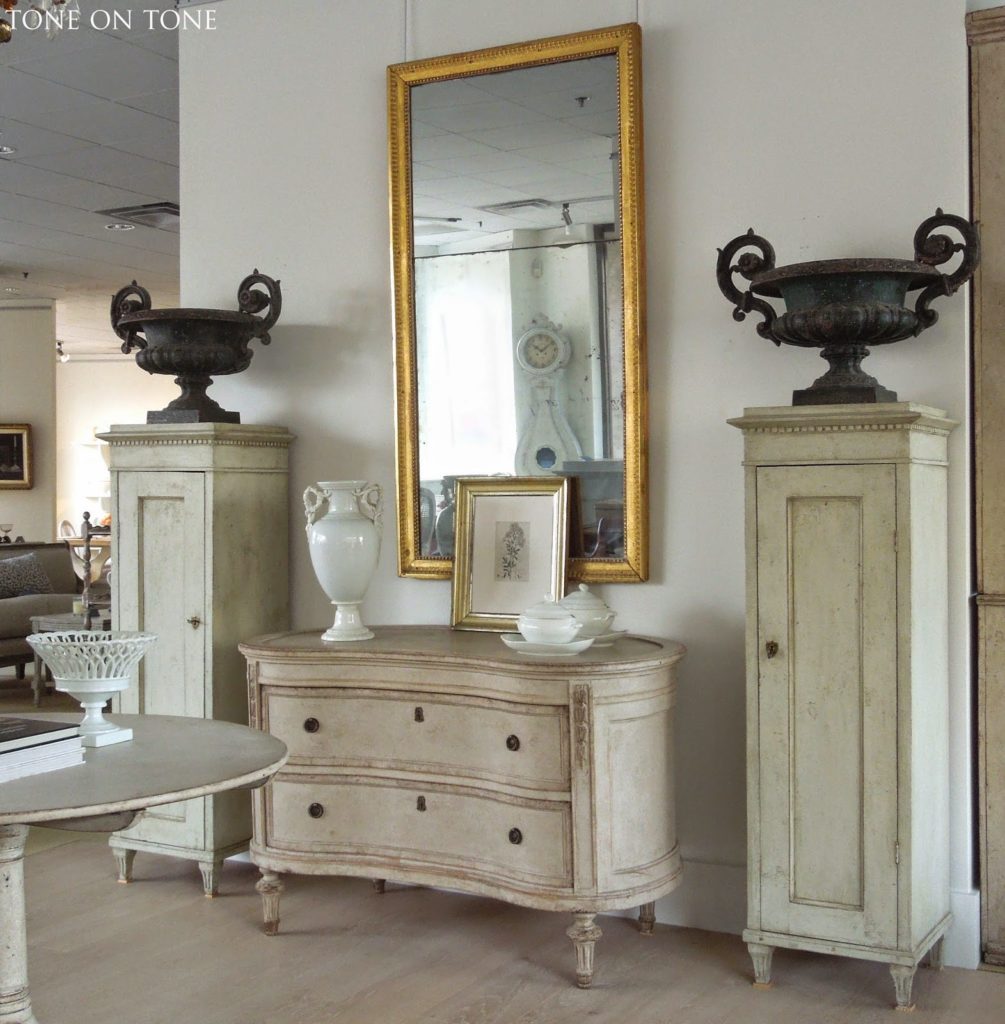
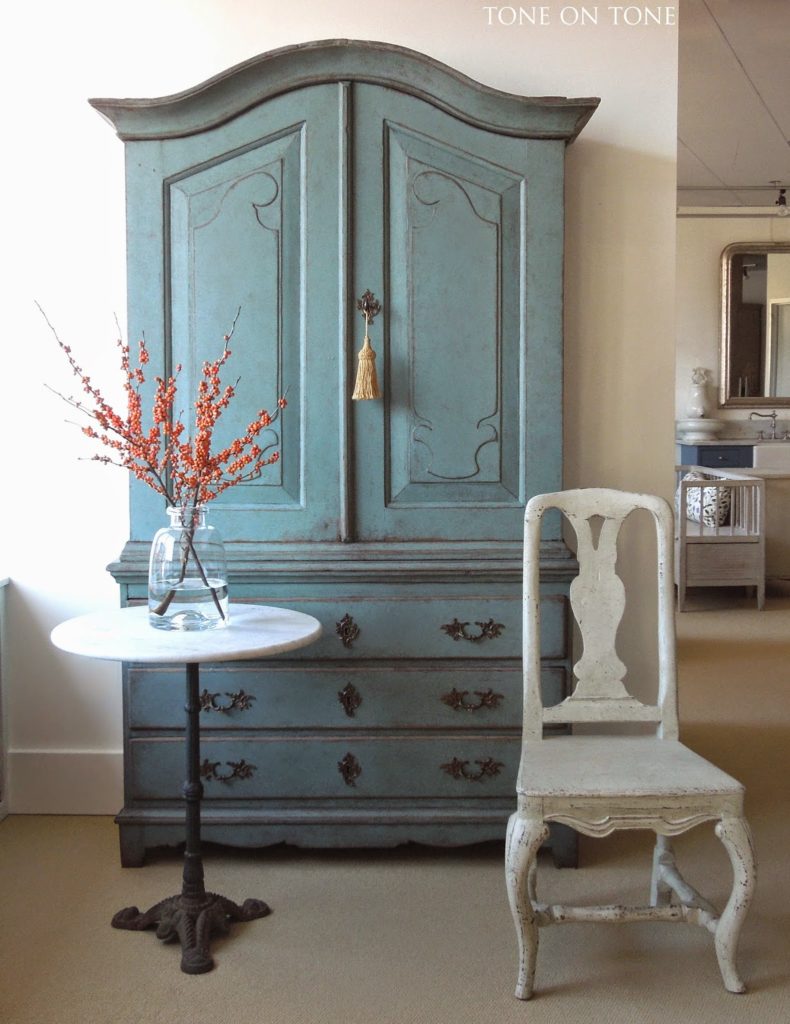
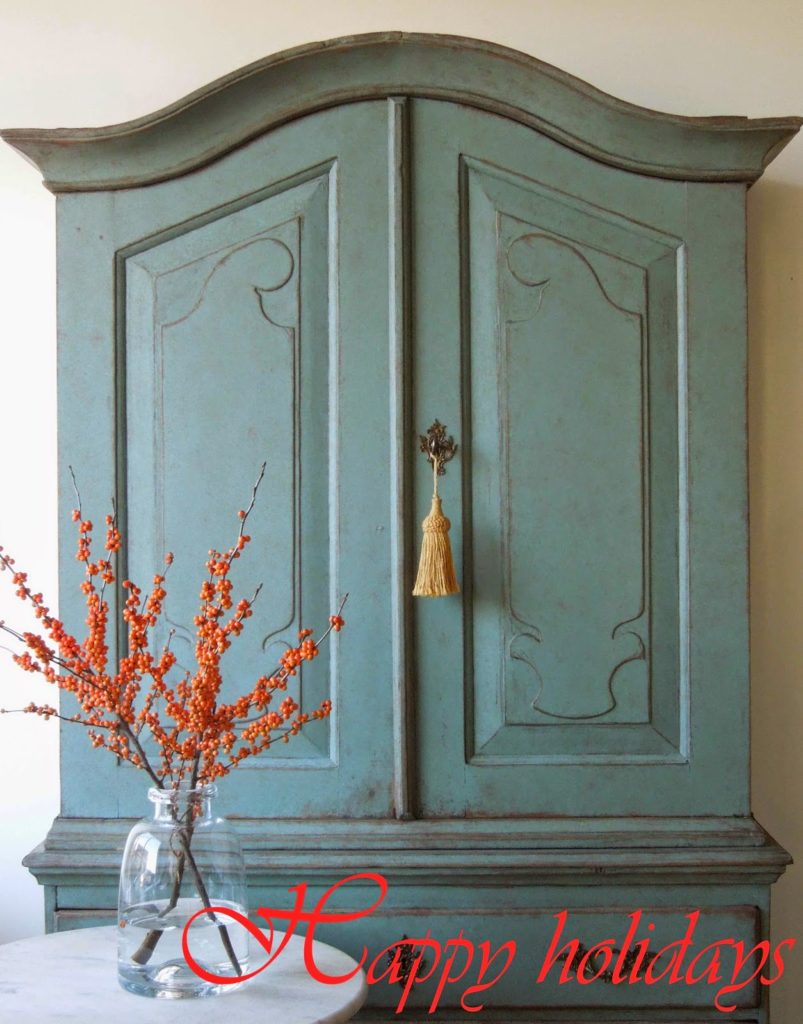
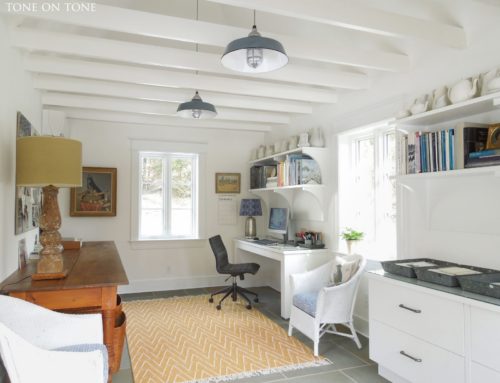
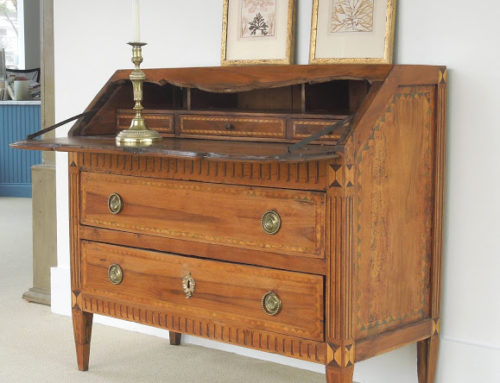
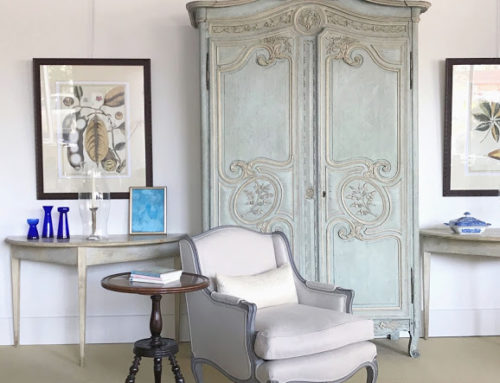
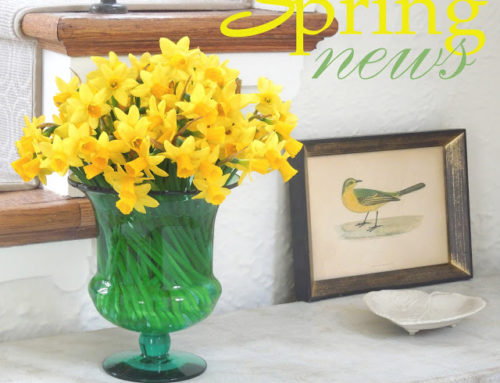
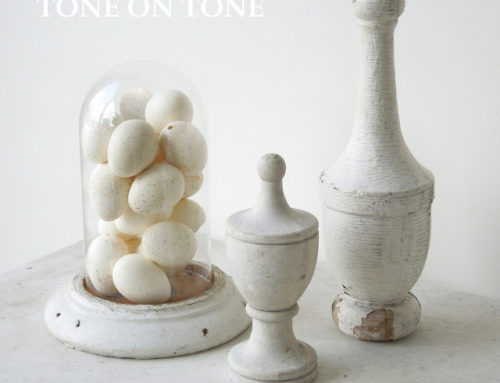
What a beautiful assortment of antique furniture! It's probably a good thing I live far away because if I ever visited your store, I might never be able to leave! I love the way you combine the antique and modern elements. My favorites are the sideboard (the first pic) and the Rococo clock. They are so simple yet elegant. I'm going to spend Christmas at my in-laws. They have a big Christmas eve party every year, and we get to hang out with Steve's cousins and their babies, so it will be fun! Wishing you and Tom a wonderful holiday season!! xoxo
I can't decide what is more beautiful or elegant than the other…I distinguish those marvellous Mora clocks, the pair of blue painted chests and secretary desk but I have to say that you have a stuff of exquisite beauty Loi! Good sells and enjoy Christmas time with your beloved ones.
Olympia
Hello Loi, It is overwhelming to see so many beautiful pieces at once. They are all so perfect that I don't think that I can pick a favorite. For practical purposes, since I don't have an established house, my eye is drawn toward the smaller chests and stands, that are easily moved and could be used anywhere.
–Jim
Wow! those clocks are gorgeous . . . and that blue desk. I hope I can stop in and say hello in January. We will be on our way to our new posting in Stuttgart, Germany.
Merry Christmas to you and yours! — Cindy
What a lovely bonanza of beautiful pieces. those desks are sublime. I think you might need to to open a place in London bc oddly enough it isn't easy to come across.
Gulp! That's all I can say. You must have one of the most beautiful collections of Swedish furniture and accessories in the land!
Thank you, Isabella! Welcome to our blog 🙂 Happy Holidays!
Impossibly beautiful. It all just takes my breath away.Merry Christmas to you and Tom and all best wishes for 2015!
xoxo,
P
Oh my, Loi, I am drooling over so many of these items. The reeding and the carved bonnets always wins me over. Btw, I am loving the modern touches you have added to your displays. I must stop in again soon. I am finding my way down more often now with a new grand baby nearby. Have the happiest of holidays. Blessings on you and yours.
Wow! That is a wonderful assortment. I am a traditional girl at heart but I like how you have mixed in a few more modern pieces. Have a wonderful holiday season!
Oh my goodness, Loi, you have me seriously wanting to rob a bank so I can come shopping!!! What stunning pieces!
Mary Alice
Just stunning! xo
I love everything in you store especially the Secretaries. It's hard to choose. Enjoy the Holiday Season.
I always aim for "Loi" vignettes but they stubbornly come out more "Andie" than "Loi'. Sigh.
I am always so inspired here, my friend. I have to run some errands but when I get home I will be scrolling through this post again!
xo
Andie
Beautiful pieces, as always, Loi. I especially like the clocks, the secretaries and the petite Swedish bedside nightstands.
Sounds like you have some wonderful holiday plans. Hope you're enjoying this beautiful season.
Claudia
im not sure anyone else can curate the way you do, loi! Merrrrrrrrry Christmas to you and Tom, Mocha and Panda!!!
Hi, Loi,
Your Swedish 1820's Neoclassic clock is absolutely gorgeous!! Despite its ornateness, I could see it fitting in beautifully with an Art Deco setting. It's those winged horses that make me think that.
Loi, so many gorgeous goodies, I need to scroll through again. I've always wanted a Mora clock, even though we really don't have a spot for one. That Baltic console is incredibly striking, but I think my favorite is the table with the candle slides. Just beautiful.
Your Christmas plans with family sound so lovely and cozy. I'm sure you'll have a wonderful time. Merry, merry to you and yours! XO
I can hardly breathe from gasping with each image. Beautiful, beautiful, beautiful, the clocks especially the cartel clock is stunning. Your shop is gorgeous and you have everything displayed so beautifully,
Merry Christmas,
Kathysue
My comment died! You are a master of scale and composition! Your color, too, is incredible! Yes, it is muted, but so rhythmic!! Love to you and Tom, Mocha and Panda. BTW, I was at a holiday girls lunch yesterday and a friend came up to me and said she found your Instagram account through me and LOVES it. Of course, I told her about your blog:) A full "Loi Moment!" xoxo, K
oh my, i'm drowning in a gustavian blue sea of swedish lovely! the curvy sideboard, the tall painted cabinets, the symmetry you rock, the elegance of all your hand selected tonal pieces…what joy, loi! thank you for sharing your spirit and your wares which are so very fortunate to be adopted by you. i am sending you love, light and hope for more radiant december days and also magic, wonder and calm for soothing winter nights. peace to you right where you are.
Oh my goodness so much lovliness! I find that Mora clock with the whimsical top so striking! Love the acanthus detail on the console. Well I will just take one of everything!! Happy Holidays Loi
Swooning, Loi, absolutely stunning sideboards, and that mirror is such a winner!
I love the juxtaposition of precious finds from several centuries!
xoxo
Karena
The Arts by Karena
Loi,
You find the most outstanding treasures for your clients. I love it all. I'm secretly relieved that I don't live closer to your shop, I'd be in serious trouble! I personally like the symmetry of the topiaries over the creamware. But both vignettes are beautiful.
Have a wonderful Christmas, my friend.
And yes, I've been in a jolly mood this whole month! Jingle, jingle!
xo,
Karen
Oh!! This shipment is the peak of perfection. With each photo, I thought that it couldn't get any better–but it did. I'm in love with the blue pieces and that refined multi-drawer "abattant" is beyond anything that I have seen of its genre. Congratulations. I do think that you have been busy.
Sending love—Mary
Loi, My husband was asking me questions that I didn't hear because I was drooling! Oh my! I love everything; you had me at hello with the 1700s & 1800s Swedish Tall-Case, Halsingland Secretary and Swedish Neoclassical ca 1820 gilded carved WOOD clock!!! Oh, Santa, just put it all on my Christmas list! You are so talented! All the best to you both. Rié
Hello Loï !
All is very very nice !!!
Have goods holidays !
Céline.
Beautiful finds Loi, you always discover the most intriguing pieces. Your eye is flawless. Sisters cooking and bringing the Christmas dinner??? Lucky you.
xo,
Vera
Every single piece is to die for, I love it all. I see you sneaking a few modern things in there…it looks so good! Santa please bring me that walnut armoire 🙂 Have a great weekend and hope the new shipment flies out the door! xo Nancy
ALL SO SO STUNNING!!! It kills me I live on the other side of the world because if I lived near by I would surely set up residence in your beautiful shop! Happy Holidays to you all and Lots and lots of love. Jx
Dear dear LOI!
I keep repeating myself, but it bears repeating: YOU ARE AWESOME! And I want everything in your shop. The lightness, the peaceful, graceful lines of the pieces and the colors….all what I wish I had. I have some pieces that give off this tone in my home, but I'd love to have at least one authentic Scandinavian piece from your shop. I need and WANT rather, a real settee in these colors.
Well, if I can't buy from you, I can always come here for a jolt of joy and kindness. I want to wish you all a fabulous time of food, family and friends. Thank you always for posting such beauty! LOVE, Anita
GORGEOUS!! I see so many beautiful pieces, love that console with the reeding and the fabulous sideboar/console then those benches, sigh it is all sooo beautiful. Thanks for sharing the beauty~
Hello Loi~what loveliness I see here…the soft colors and then the soft color of blue added in later for a surprise. Hope you are having a very successful season and enjoying all it has to offer!
Hi Loi ~ I just love your posts that are packed with great information! I just love everything you posted and definitely, I dream about those clocks! Oh, my…. I wish I could visit your store, it looks stunning! Happy Holidays to you too!
Each piece is stunning! I needed to go back and look twice at them! Great shipment!!
xo. Leslie
Segreto Finishes
Oh I wish I could "Drop-In". I would love to see your shop.
MC and I wish you, Tom and your families the Best Christmas ever!
I don't cook either and count on MC to do it all!
xo
Patty
WELL……….its a BAD thing for YOU I live way on the other side of the USA!!!!!I spied a few items…….that I do not need but could easily purchase!MERRY CHRISTMAS…………..and lucky YOU just picking up pies.That in its self is a HUGH GIFT!Pop over and see me with my facial mask on!Might make you smile…………!TRA>>LA!
I want one of every gorgeous piece please!
So many beautiful things, Loi. I hope I get to visit your shop someday. You stage everything in beautiful style. Makes one feel as if they are in your lovely home.
Happy Holidays! Sounds like you will celebrate in style with plenty of good food. '-)
The 18th century Baltic console and the cartel clock are calling my name. But there are so many wonderful pieces and beautiful colors! A beautiful shipment.
Postscript…Loi I picked up a wonderful set of 10 Thorvaldsen bisque plaques at the auctions here in LA. It was you and your blog that turned me on to his work, so thank you for that!! Having read your prior post about the museum, I knew what they were the moment I spied them at the preview.
Gah! It's all SO DAMN GOOD. I think this is my favorite shipment of yours overall. That second sideboard should either be in a museum or my house.
Whoa!! How I would love to stop in. That vitrine is lovely and an heirloom.
Insanely gorgeous! All of it! But… I really want to marry that serpentine sideboard and have it's babies. xo, Laurel
A shipment of treasures, Loi, all the way from Sweden, styled so elegantly, showing the many facets of each piece, its pretty and practical nature. Your Christmas plans sound exciting, with family and friends and scrumptious fare! Hope you take some pics for us to share in all the festivities.
Happy weekend, my friend1
Poppy
Happy Holidays Loi! Wow, what beautiful pieces you have to share! Sure wish I lived nearby- would love to pop by and see your shop. Love the curvy sideboard and those sweet little bedside tables. A mora clock will be mine at some point and will have a permanent place in our next project-they are all just perfect! We had a buyer for our PB home and then she changed her mind-we're back on market with a steady stream of people coming through-so we are confident it will sell again soon. I'm already planning the next renovation… the barn house will become our next european farmhouse -picking up where we left off plus incorporating even more renovations. All the best to you and Tom for a wonderful holiday and new year!
XO Sarah
You've made day, Loi, with all these beautiful things. Happy Holidays to you, best wishes for a wonderful New Year! Hugs from Liliana
Loi, your sisters might let you off the hook on the cooking–but I won't! 🙂 I wrote a post on cooking sous vide. So you have no excuse! Haha.
Wow, I'm always stunned that you can keep finding so many beautiful things. I want to come shop. Merry Christmas!
Absolutely exquisite, pale loveliness! Your style is unmistakeable, Loi!
Loi! This shipment takes my breath away! Each piece is stunning and as I look at them I try to imagine their history and who might have enjoyed them over the years!
Happy Holidays! Enjoy your families.
Everything in your latest shipment Loi is superb – but I am particularly attracted to the cabinet with trompe l'oeil laurel wreaths. I am sure that all these pieces will be flying out of your shop doors very quickly.
Hope that you and Tom have a wonderful and happy Christmas
Hello Loi
All items were selected with the utmost care, as is clearly visible in this shipment.
Wishing you and Tom the joys of Christmas
Helenx
Loi, Loi, Loi-
You never disappoint! Such a beautiful collection of antiques.
I hope that you are having a wonderful holiday season.
Teresa
xoxo
Merry Christmas to you and yours! If I had a million dollars, I would purchase everything on this post! As usual, your taste and selection is exquisite!
That Blue Mora clock and secretary are just delicious! What a lovely collection! Sending you and Tom the warmest of wishes this holiday season Loi. xx
Que Mara Villa de muebles preciosos me han encantado.
Te animo a echar un vistazo a mi post verás algunas ideas realmente interesantes, que creo te pueden inspirar y harás un paseo por los mercados de Navidad de Barelona. Deseo que pases un buen rato y espero que te guste y si es así y no eres seguidora espero que te hagas, gracias por visitarme. Elracodeldetall.blogspot.com
Loi, where do I begin?! Exquisite finds and so beautifully styled. I can't choose a favorite thing but that clock is top of my list.
Merry Christmas to you and Tom. It sounds like your plans are all falling into place. Have fun with all the family!
We are returning home to Calgary from the mountains today. Sunny and cold here. Xox Terri
Ahhhh….talk about a peaceful place and homey environment…Loi, your shop and home are my dream abode. But love lives in my home, and that is good. May love fill your holiday festivities and BEYOND, forever. Seasons greetings to you and Tom and your family! ENJOY and thank you dear friend for YOU. Anita
The beautiful pieces you and Tom find are always so special and absolutely beautiful. My favorites are the Halsingland secretary with the topiaries, the two blue little chests that would be fun to decorate a bedroom around and the laurel painted cabinet. Cheers to you for sharing so much beauty with your readers throughout the year and for being such a gracious gentleman too! Merry Christmas and happy 2015 too!
Oh my goodness Loi…..what stunning pieces, all of them! I so wish I lived nearer your beautiful shop! Back here in the UK, continuing the Swedish theme, we have just had our first Christmas 'Smorgasbord' here at home to kick start the festivities. Your Christmas plans sound lovey, and I wish you and Tom and your families a very Happy Christmas and wonderful New Year!
Sophia xx
Loi! Every piece is exquisite. You've converted me to the "Loi Look"! I love it. Hope you and your families have a great Christmas! Best for the New Year!
Linda
Oh my goodness, the clocks are just magnificent! I swear, one day I will have one of those!!!! They are just the perfect heirloom piece and I know worth every penny! I'm so glad your holiday plans sound really fun and family-filled, that's what the holidays are all about! You enjoy my friend and a very Merry Christmas to you and Tom!!!!
Your furniture is exquisite…I must stop in and visit your shop the next time I am in the area!!!…
Oh Loi,
Your shop of authentic beauty and grace is more then one could handle. You find the most intriguing pieces, shapes and sizes it doesn't matter it's all chosen with a discerning eye for all the right kind of rightness here. How I would love to visit your shop of wonderment. Perhaps one day I will indeed do so. I have to share with you a dealing in finds of beauty, I too look for those kind of pieces that have very little life in them, pieces that have been loved or disregarded as to pieces to love and theses pieces end up ones junk in piles on the side of a home, or in a junk pile as disregarded junk. This is where I come in taking an old humidor French smokers cabinet with legs bent twisting in weathered shape to as not being able to restore or stand on its own, along with any disregarded French Rocco mirror parts and frame pieces, chair bits and wood scraps and wire to then create another beauty of its kind in the building of my very own French théâtre, one that will entertain the past life it parts once had.
Come see my latest creation that takes center stage with all who visit.
I am wondering what you think of another theatre and one of my most exiting of pieces to date.
See you soon,
Looking forward to more of your beautiful home.
Xx
Dore
Beautiful, Loi. You may yet convert me to Swedish design, maybe even to blue.
Have a lovely holiday season,
b
Where to begin?! So much loveliness in one post Loi…that vitrine is gorgeous as are all of the other pieces!
Wishing you, Tom, and both your families a very Merry Christmas and Happy, Healthy, and Prosperous 2014!!!
xo Kat
Whoa! I can't imagine unpacking those crates…it must have felt like Christmas many times over!! Have a MERRY!!! franki
Thank you, Franki!! Merry Christmas 🙂
What an amazing shipment – Christmas came early to you!! Just love the secretary and of course, the clocks are always a favorite. Wishing you and Tom a wonderful holiday season!!
Oh, my heart stops a few times Loi! Everything is so beautiful!
Merry Christmas to you and your family! Have a lovely holiday time with your family!
Blessings,
Vesna
A very Merry Christmas to you and Tom! Wishing you many beautiful blessings, dear Loi….
Everything you have shown here is gorgeous, but my favorite is the very last photo…that aqua with a pop of red…wow! 🙂
Sending lots of love,
– Irina
All lovely pieces, Loi. Wish I was close so I could come and shop!
Happy 2015!
Just wanted to pop back in and wish you and Tom all the best in the new year!! Thanks for all of the beautiful inspiration!!
LOI! Good morning and happy new year! How lovely to see your comment this morning. I hope you and your loved ones had a sensational Christmas and New Years! Every time I come to your blog and enter your shop, I just can't believe the amount of beauty you have stored in one place. A candy shop indeed for the designer/homemaker. Sending you my best wishes for a most WONDERFUL 2015! Anita
wonderful pieces, special for your console. just for your information, in indonesia we are is a solid wood furniture manufacturer. we produce all furniture from mahogany wood, teak wood and another wood. we are expert skill on classic furniture, french furniture and colonial furniture. please visit my site to http://www.indo-furni.com
thanks
Are the clocks for sale?
Hey keep posting such good and meaningful articles.
Modern, fuel efficient, good fit and finish, quality of after sales service is great (Fiat is useless in this department), good resale value.
door handles